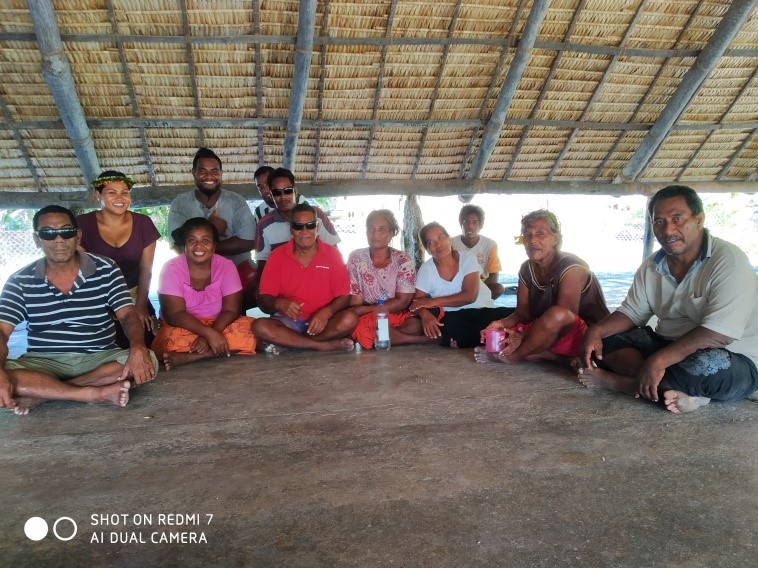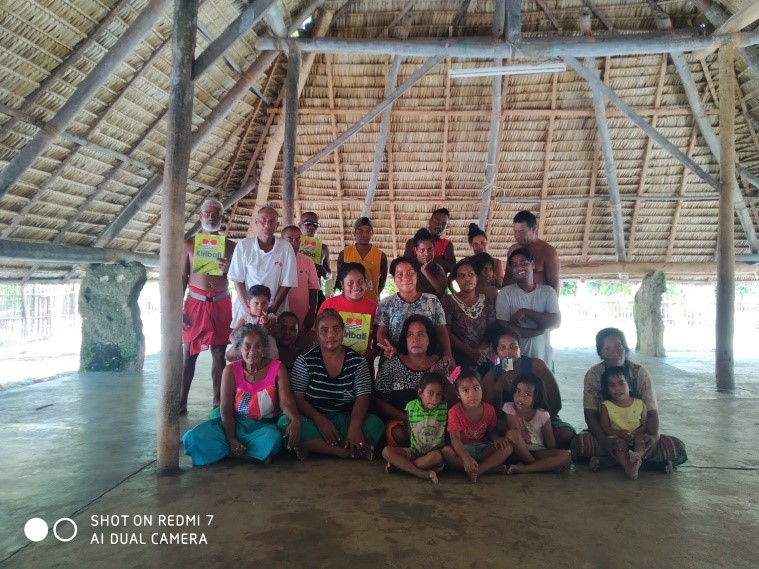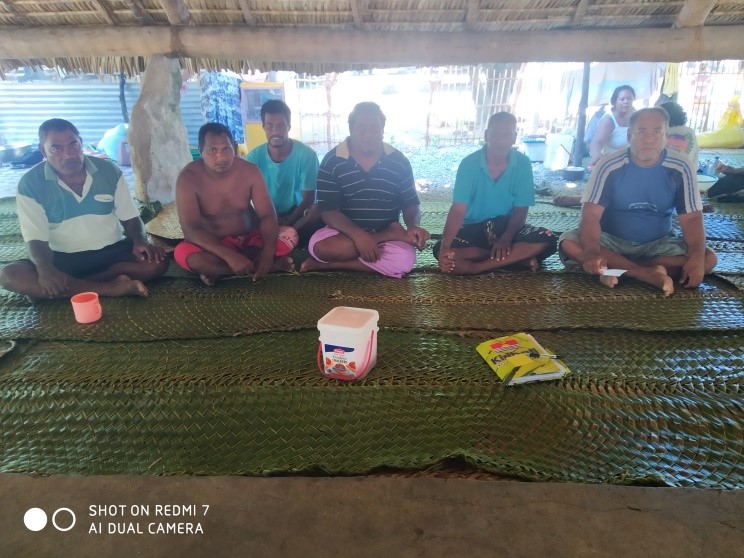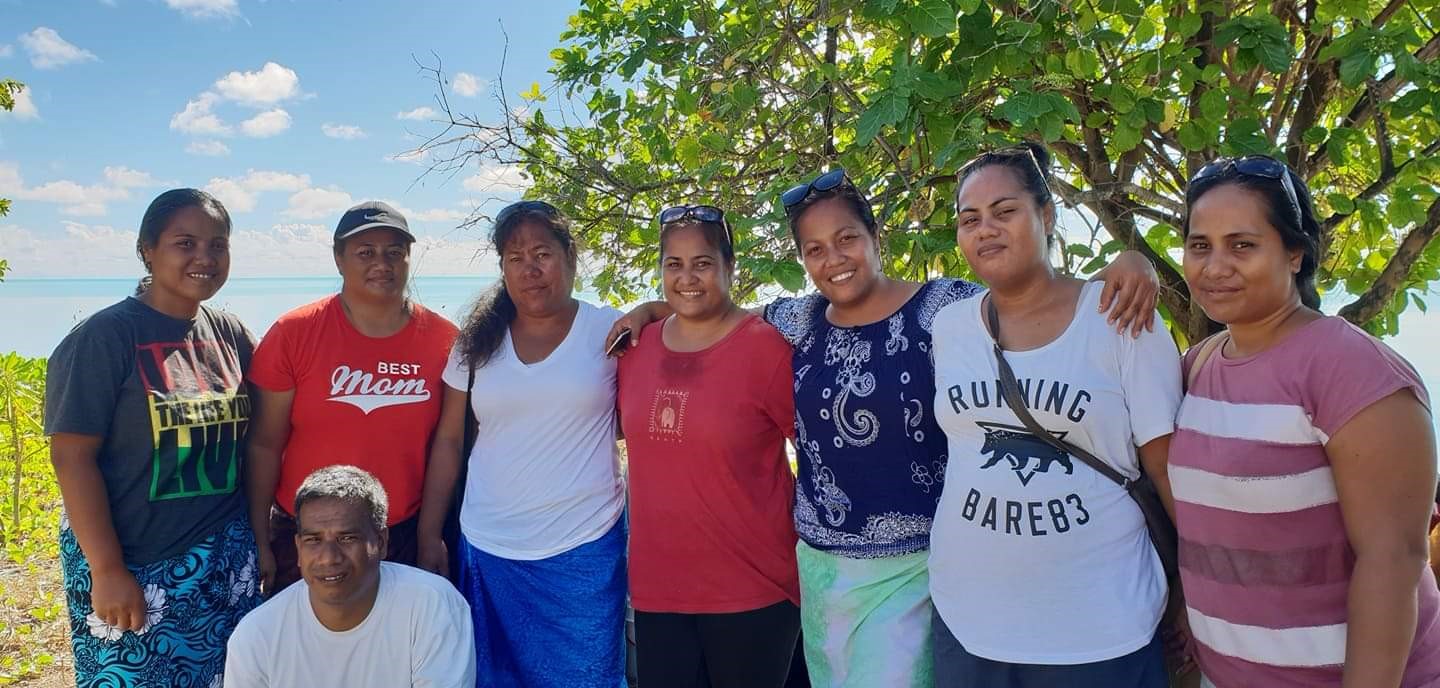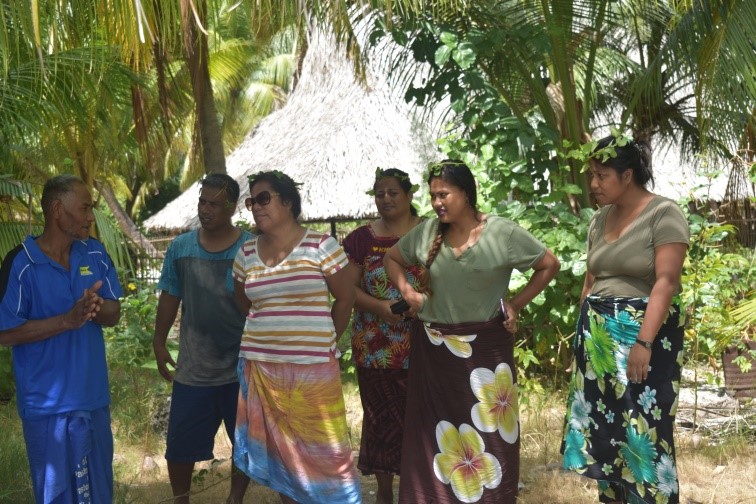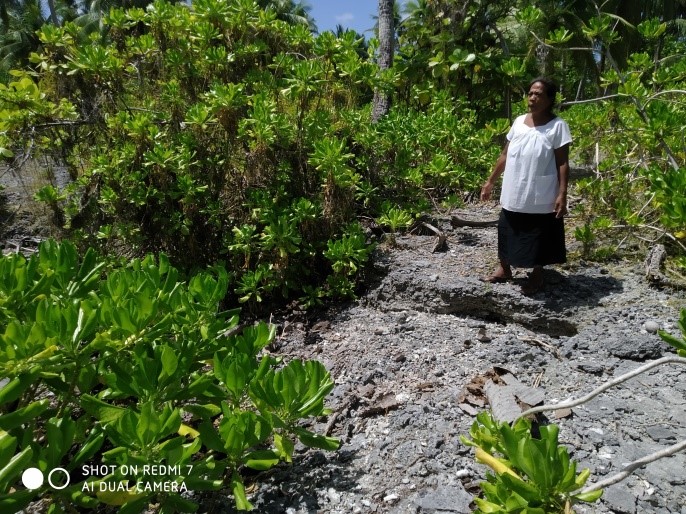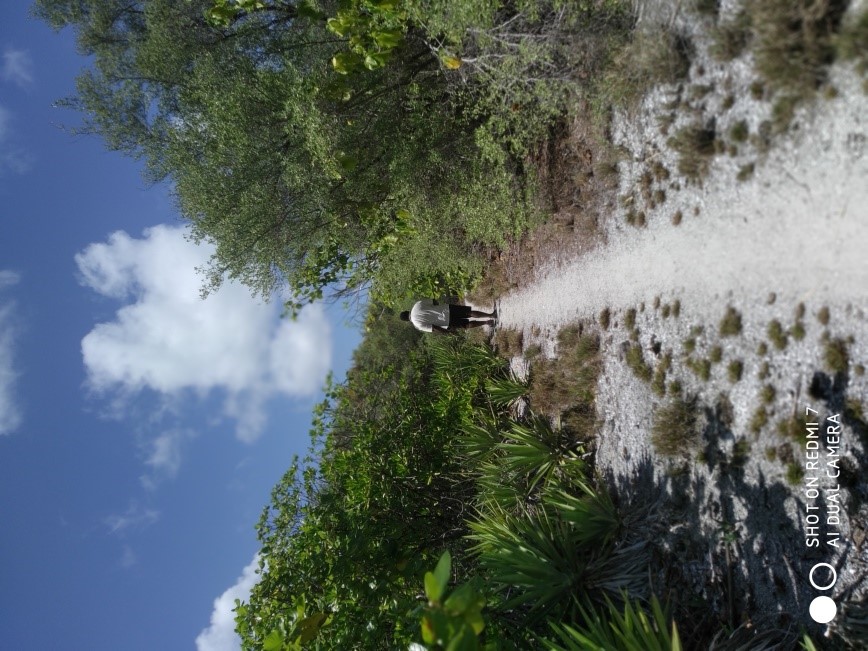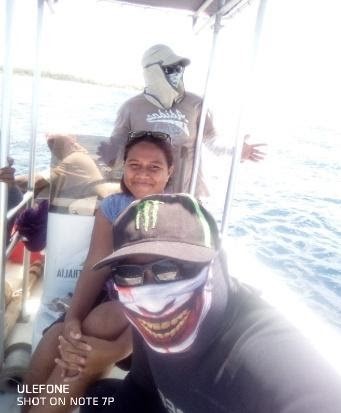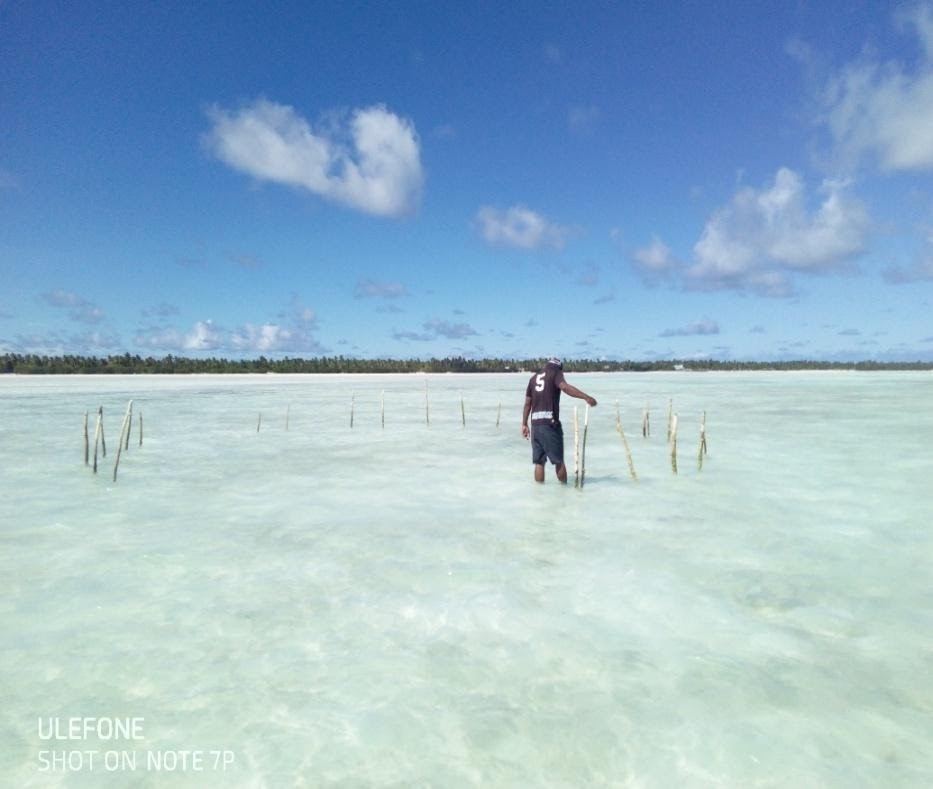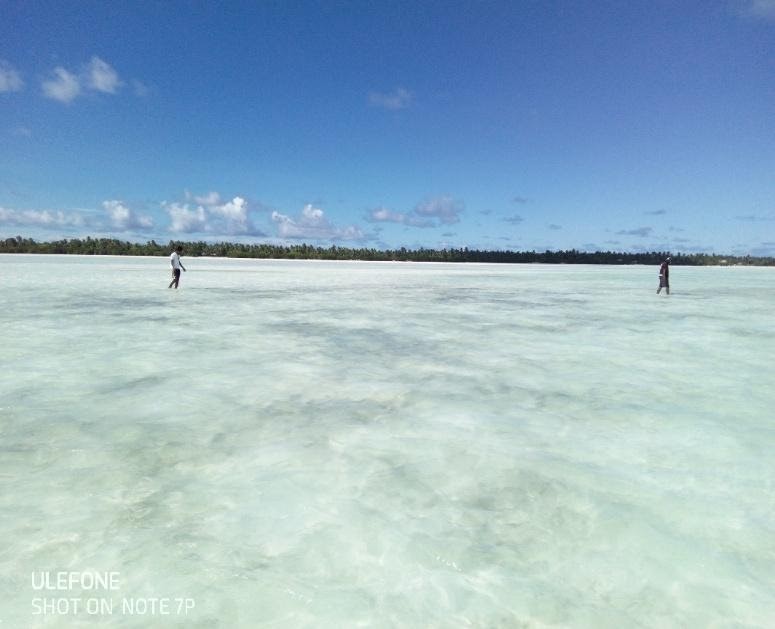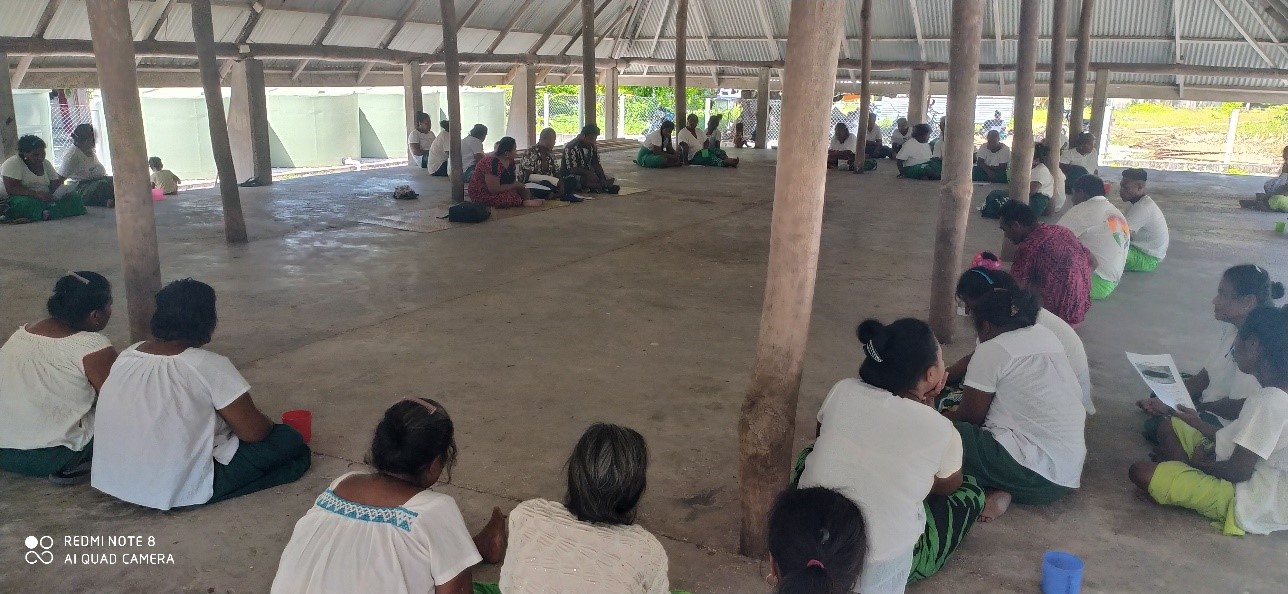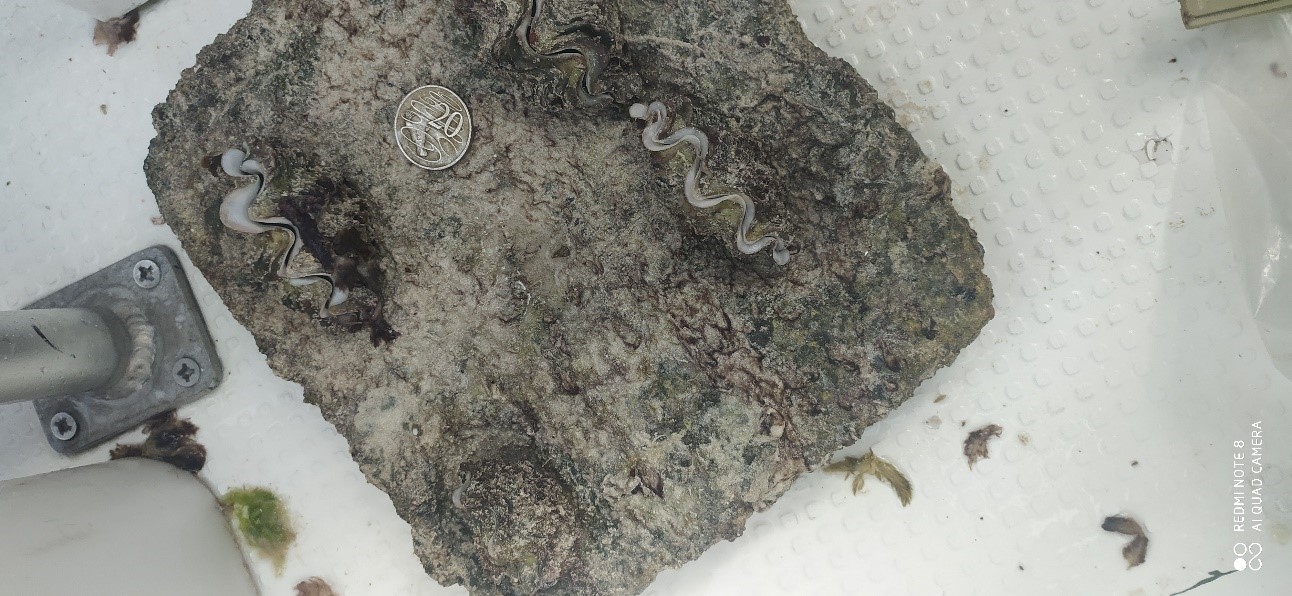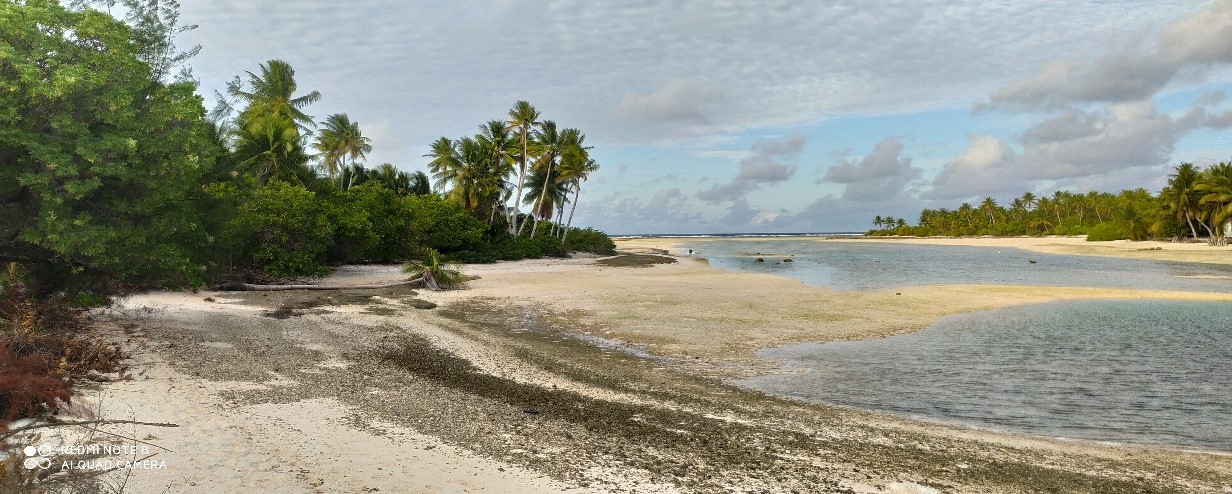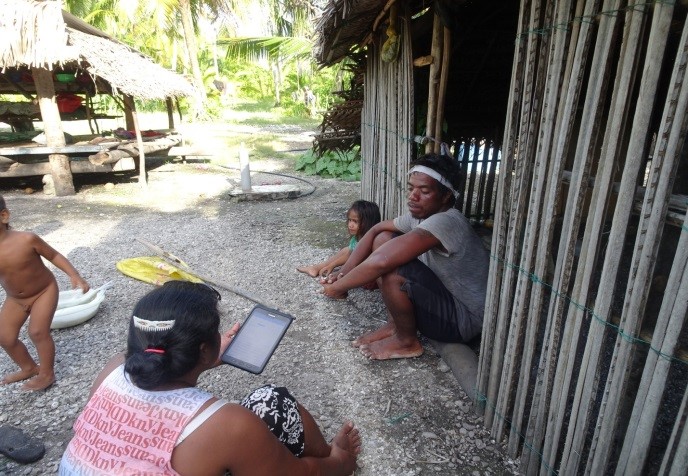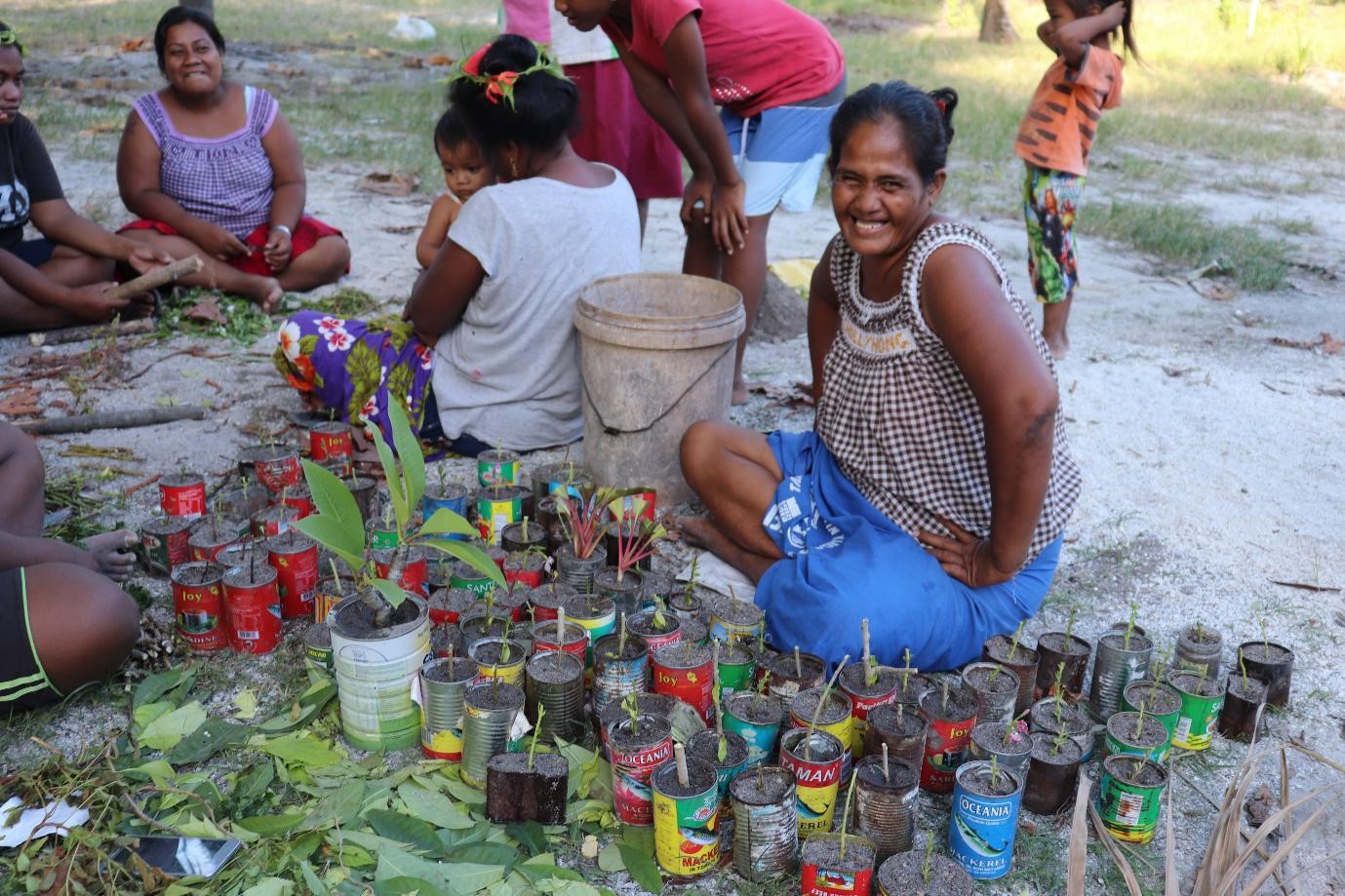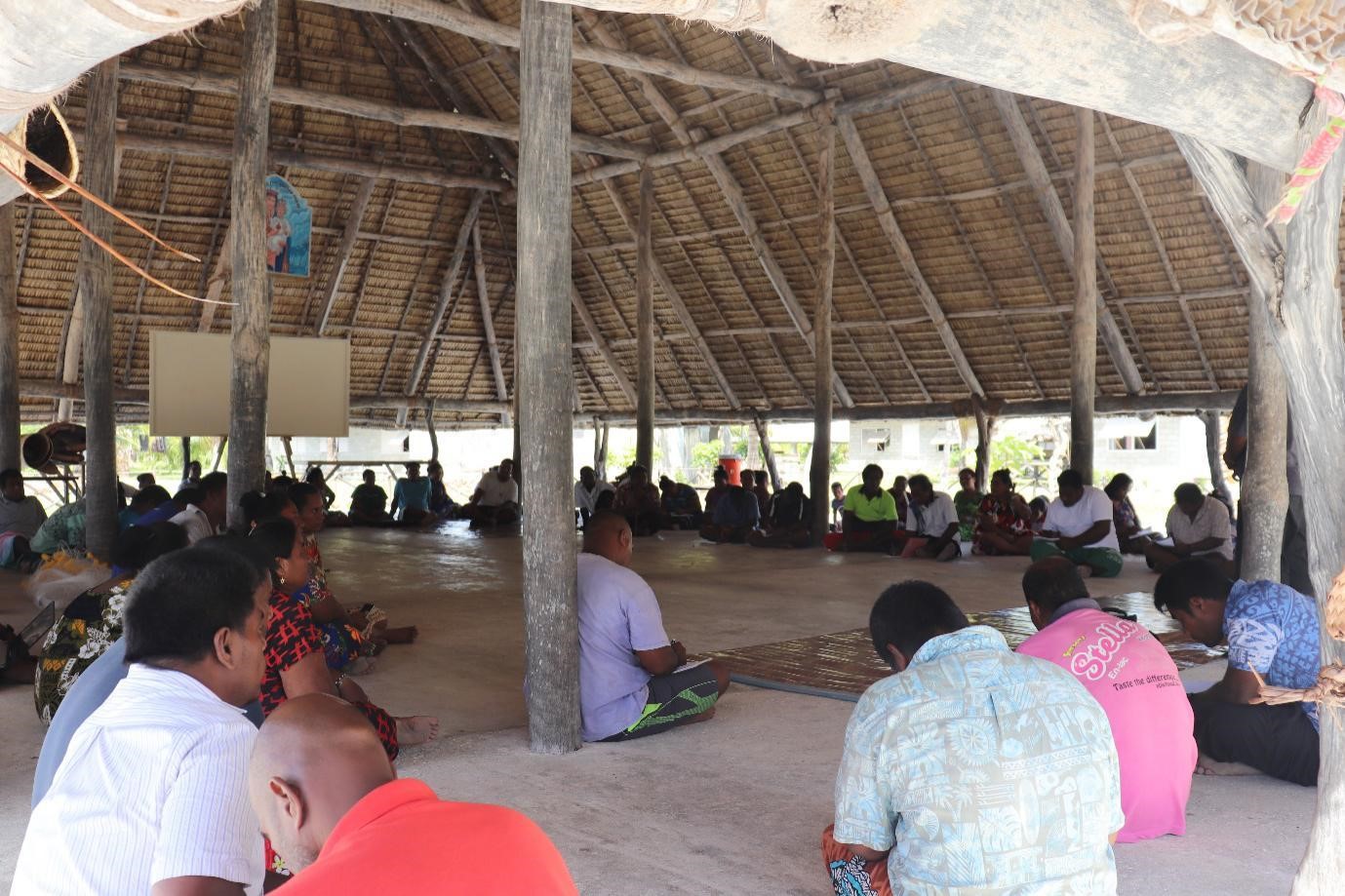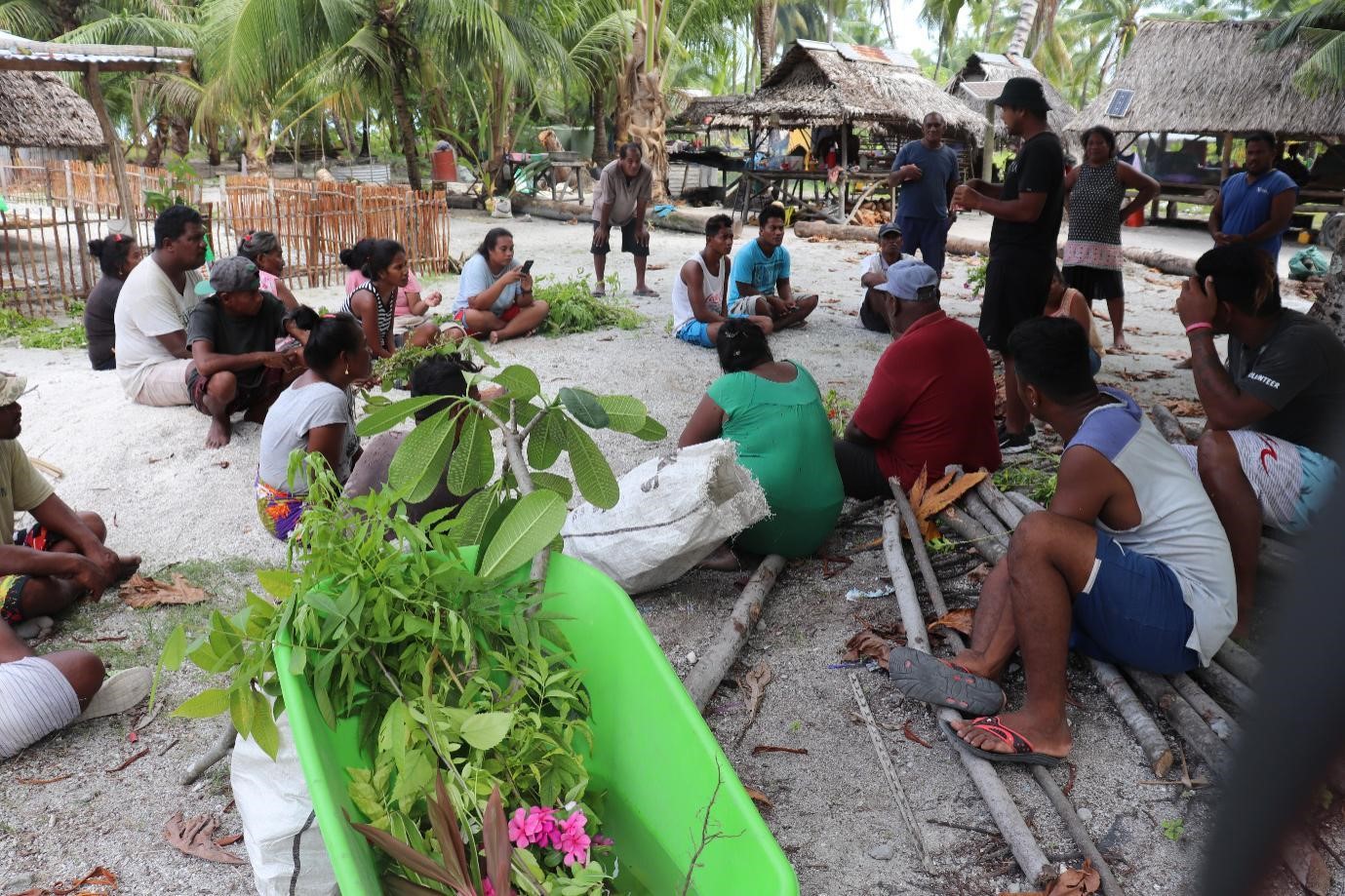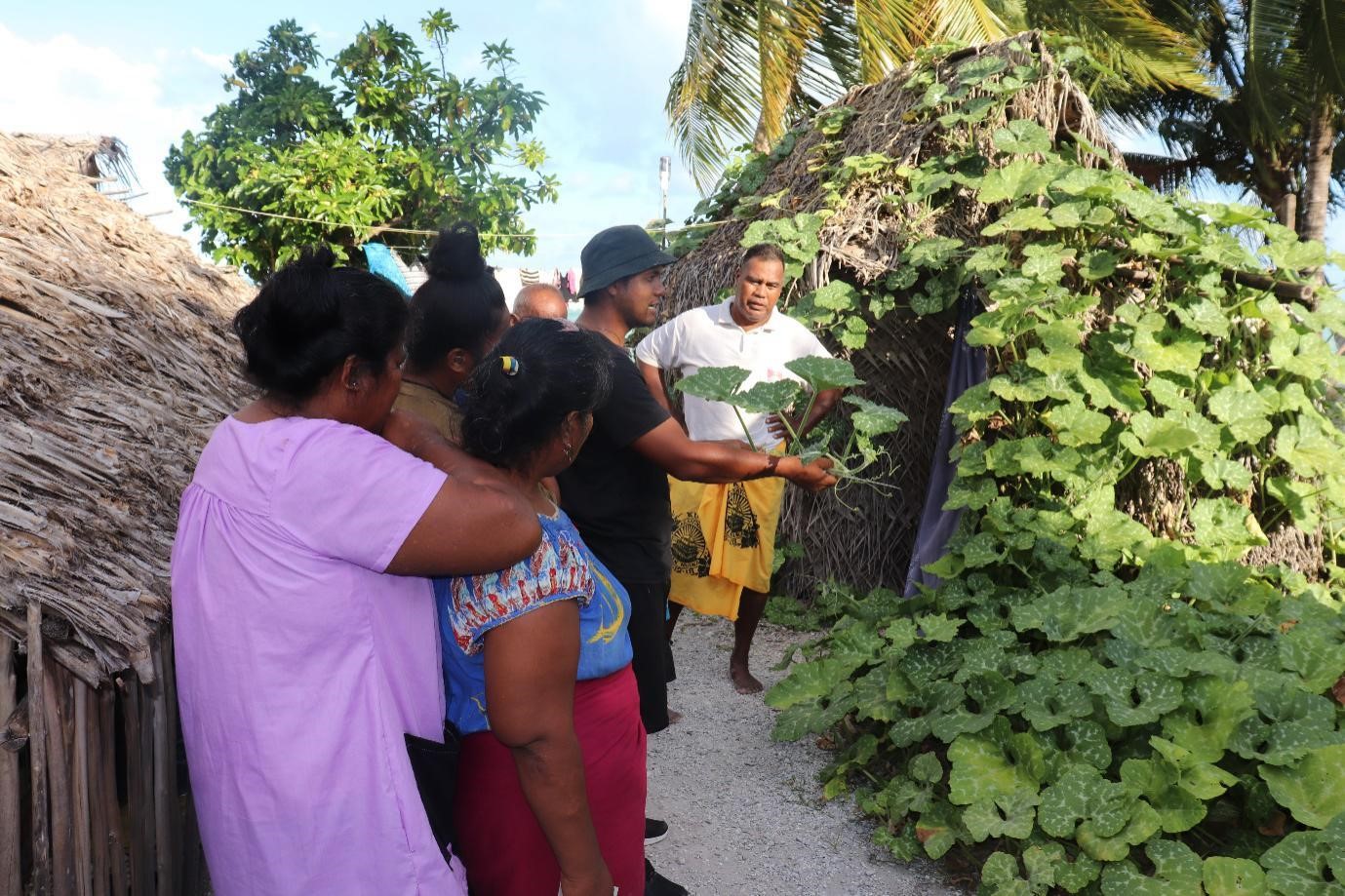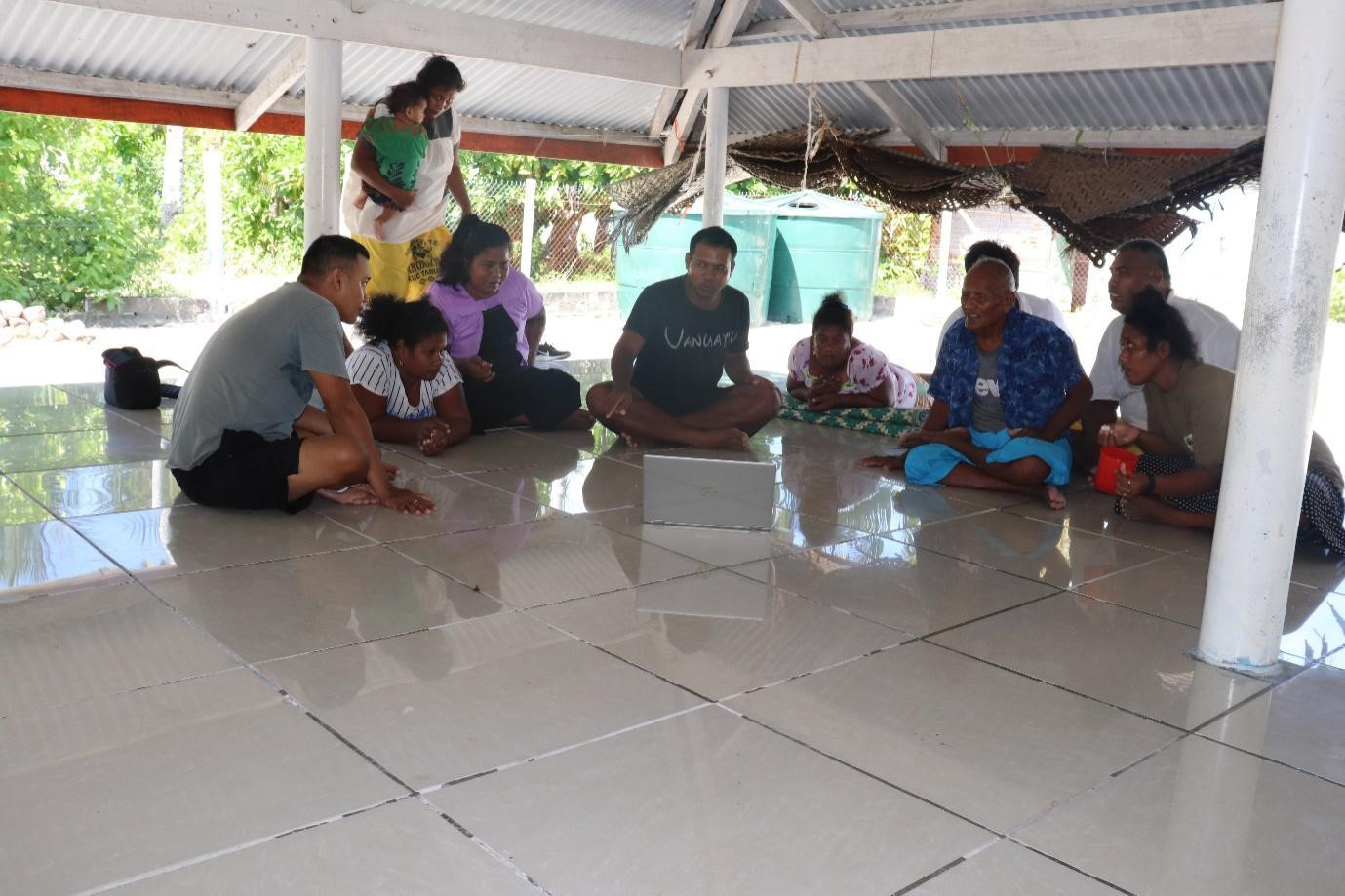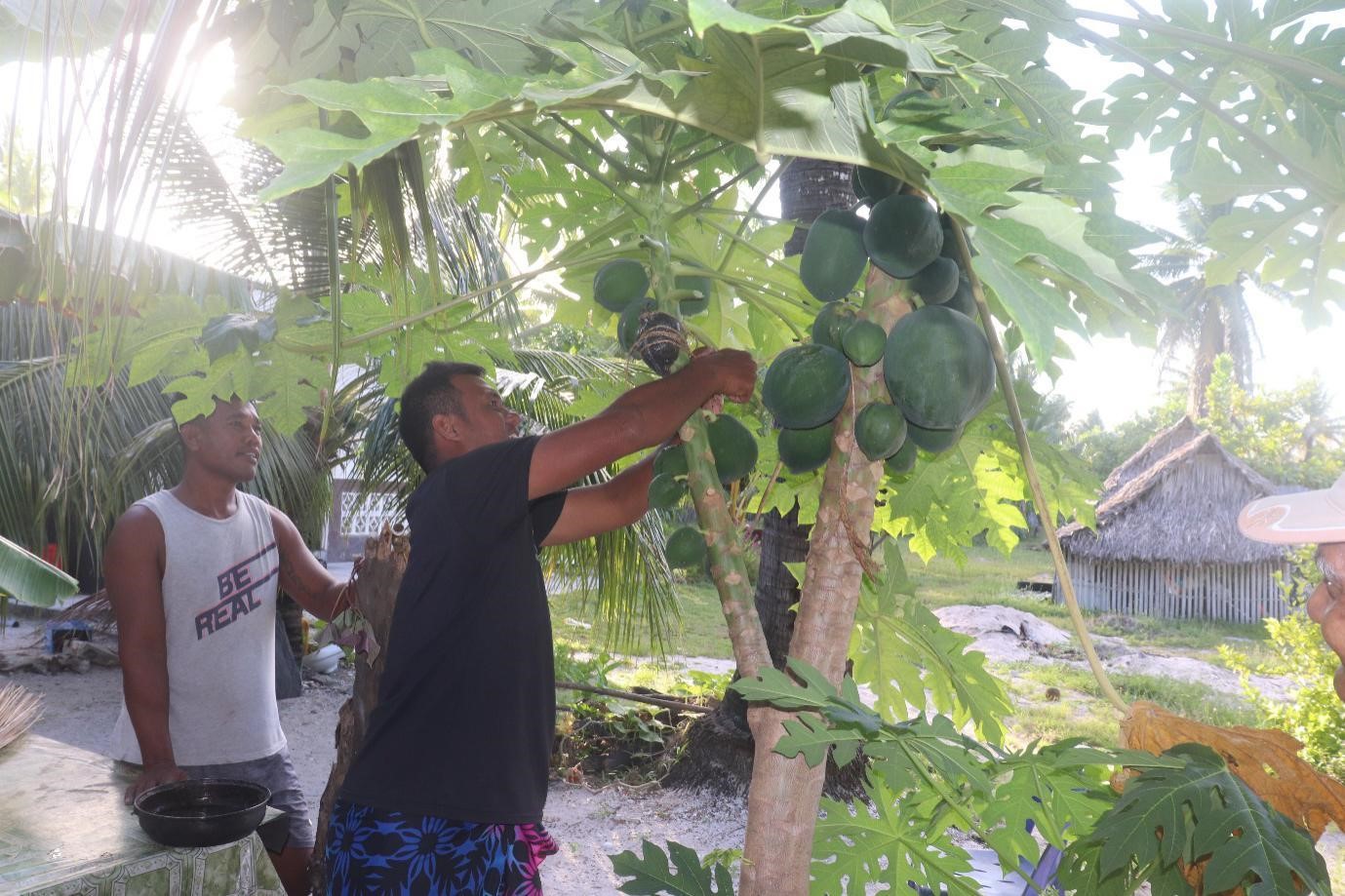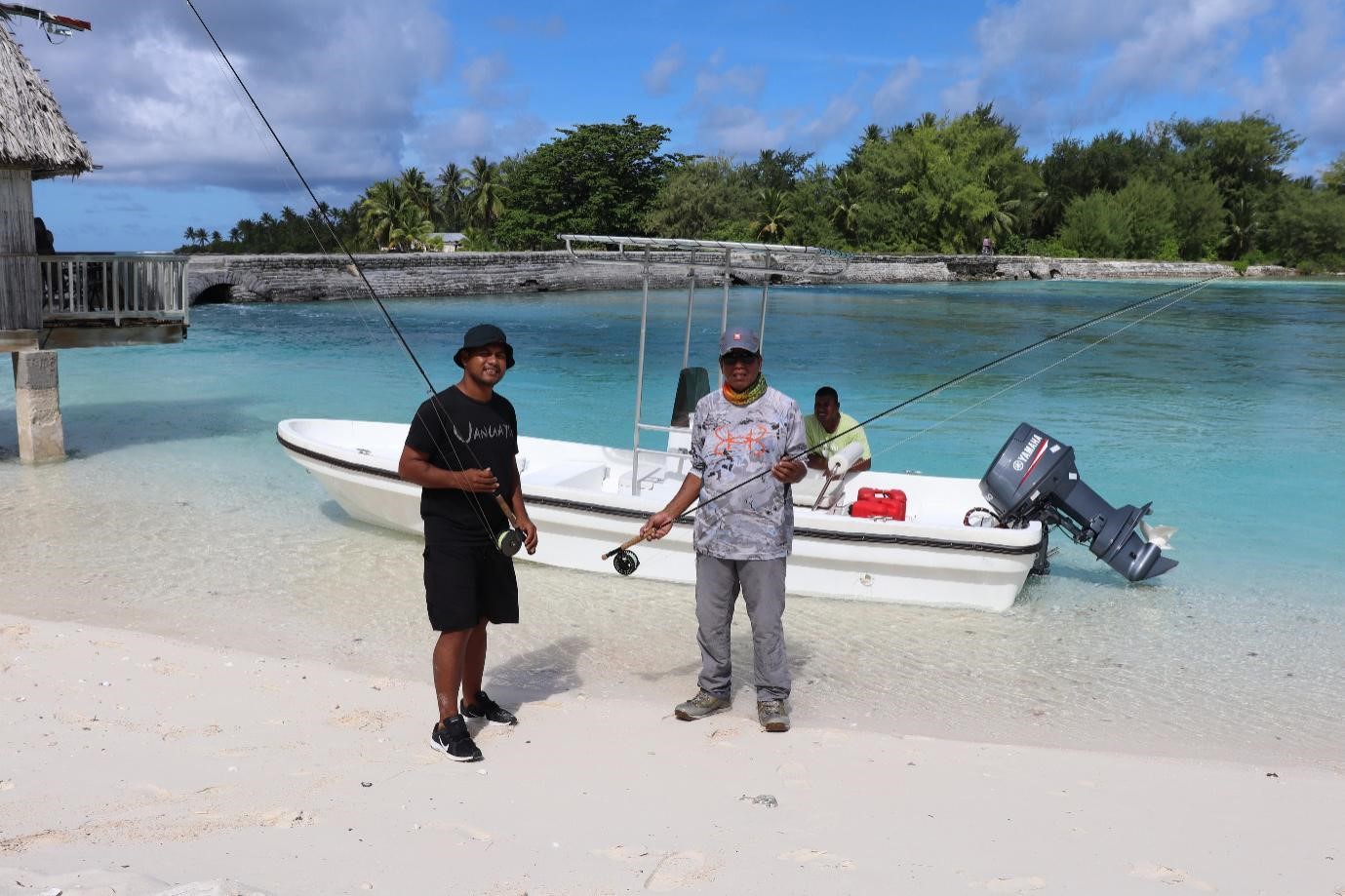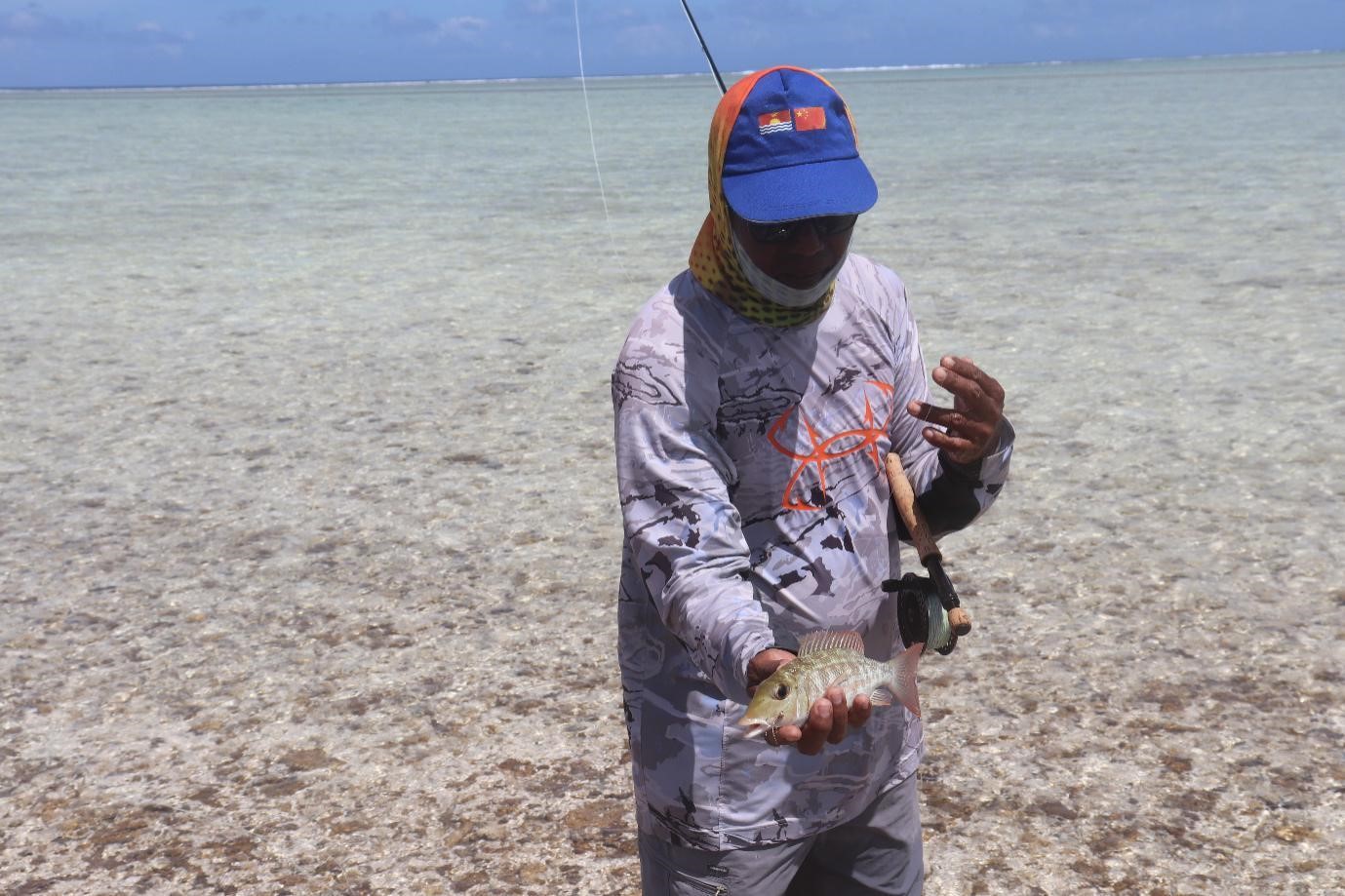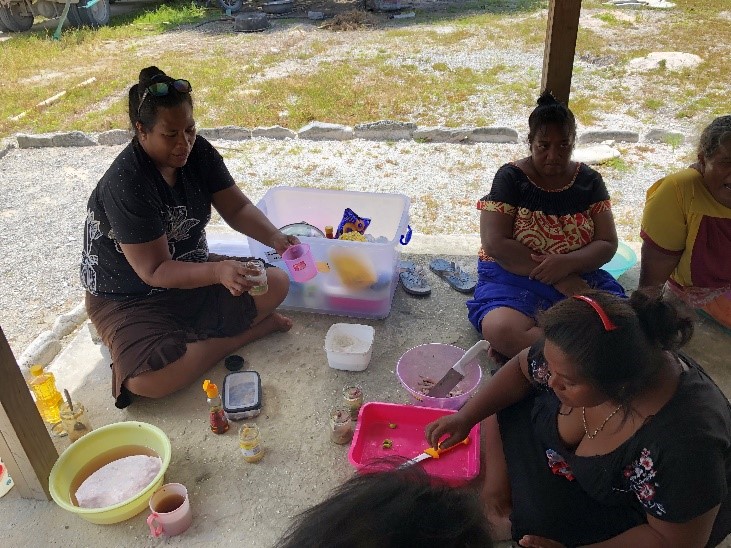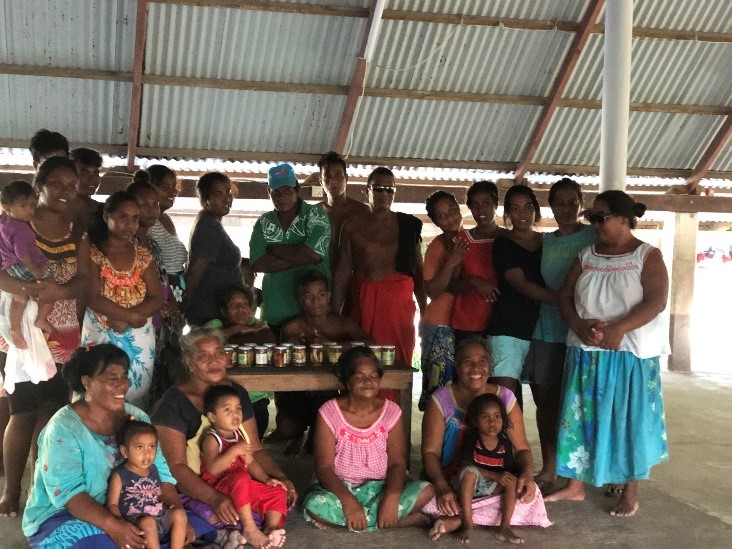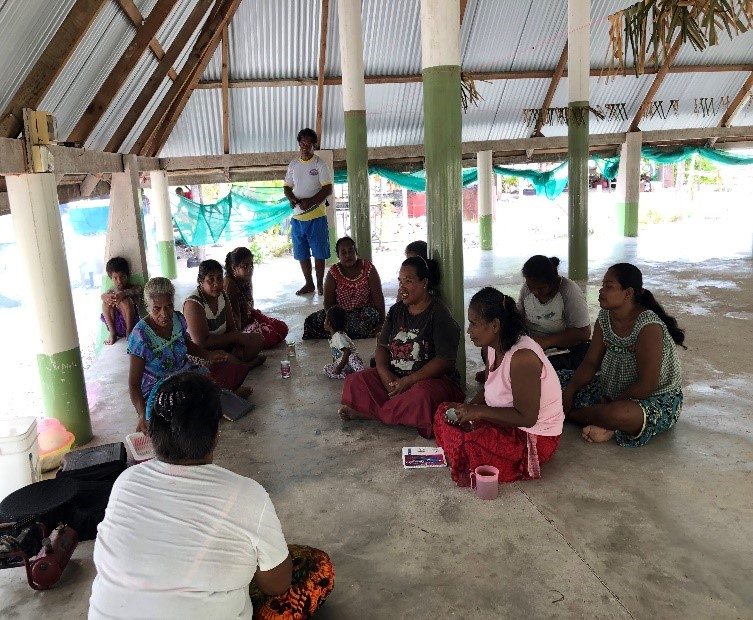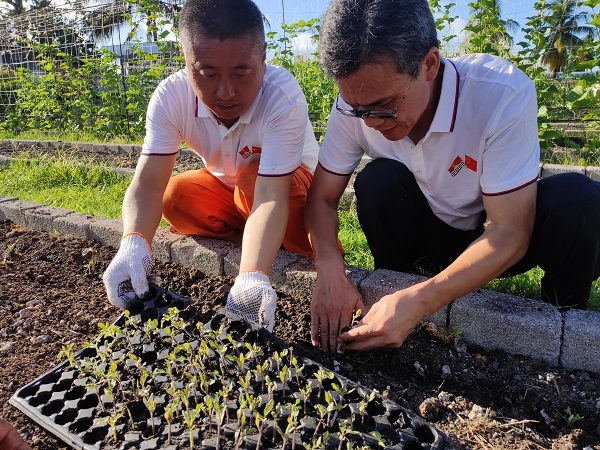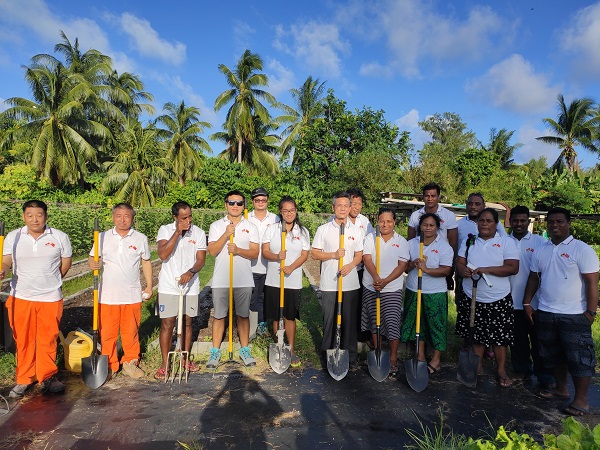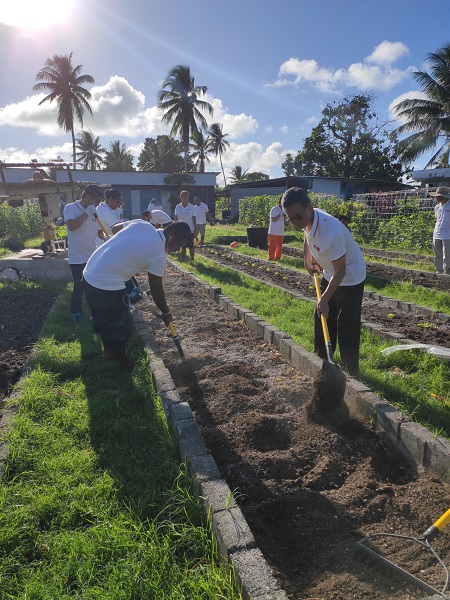The Official Handover of Maiana`s Resource Management Plan And Constitution to the Island Council.
The island of Maiana had hosted a feast at the island council`s Maneaba, called Te Ingungu n Tabwakea 2, to celebrate the handover of their island policies on 2nd May, 2020. The official handover was done between the leader of “Te Bau n Maiana,” and the Director from the Environment and Conservation Division. It was attended by councils from villages and officers from MELAD who came for the handover. This policy targets the safeguard of nature resources in Maiana that could benefit and be used by locals. The MELAD team joined by the leader of “Te Bau n Maiana” have visited the twelve (12) villages of Maiana informing them about their island policy, so everyone is fully aware and understanding of the policy. During the handover celebration, the leader of “Te Bau n Maiana” commended that his island is ready to initiate the policies with all costs. The Director from ECD-MELAD added stating the involvement of ECD in guiding and supporting Maiana with their new island policies. This island policies will contribute in addressing other relatable Environmental policies that council of Maiana was and is working on them. As part of this island policies presentation to the council of Maiana, the Ministry of Women, Youth, and Social Affairs had given confirmation certificates to Te Bau-ni-Maiana as a recognition that their Organization is part of any policy initiations on the island. The hope for this island policy in Maiana is a two-way initiative with MELAD through the Environment and Conservation Division in safeguarding and protecting natural resources for future generations. The trip was supported by the Food Security Project, commonly known as the LDCF-1 which is funded by the Global Environment Facility (GEF) through the UNDP and managed by the Environment and Conservation Division (ECD) under the MELAD.
E bukamaru te abamakoro ae Maiana n 2 bongin Meei 2020 bwa kanikinaean anganikina rabwatan ana kainibaire ma ana oi n tua are e butimwaeaki iroun te Tia Babaire n te Bau n Maiana ma iroun te Tarekita n Aobitin Tararuan te Otabwanin man te MELAD. E tiainaaki te kainibaire aio iroun Te Katuumara ao te Tarekita man Aobitin Tararuan te Otabwanin. E karaoaki te bukamaru aio iaan mwaneaban te Kauntira n Maiana ae te Ingungu n Tabwakea 2, are e kairaki iroun Te Bau n Maiana ma te Kauntira n raonaki ma ana rabwata te tiim man te MELAD are e roko n te tai aei iaon Maiana.Aio te kainibaire are e boboto iaon Kawakinan ma Tararuan Marin te aba ae Maiana mai taari ao ma iaon te aba are e a taubobonga raoi ngkai ao man tauraoi n mwakuriaki irouia kain te abamakoro ae bwanin. A katoaaki kaawan Maiana nako aika tebwi ma uoua (12) n anganaki rabwatan te kainibaire aio iroun te Tia Babaire n te Bau n Maiana are e butimwaei booki aikai n ikotaki ma te certificate ke te beba n kakoaua ibukin kinaakin aia Oi n Tua are e na kamatoa mwakurian aia kainibaire.Inanon tain te maroro n te bukamaru aio e mwaneweia man kamatoaa n ana maroro te Tia babaire n te Bau-Ni-Maiana bwa e tauraoi nanon te abamwakoro ni mwakuriia kanoan te kainibaire aio n oin korakorana. E reitia te Tarekita man Aobitin Tararuan te Otabwanin n ana maroro bwa e na teimatoa Aobitin Tararuan te Otabwanin n anga ana boutoka n kaineti ma mwakurian te itera aio. Tiaki ti ngaia ma e kamataata naba aron kakawakin te kainibaire aio ibukin kabwaian te abamakoro ae Maiana ao n mwaneweia bwa aio teuana te kainibaire are e na kona naba n buoka aron kakororaoan mwakurian taian kainibaire ake iai irekerekeia ma ana itera te Otabwanin ake a kaman tia n wene ao n mwakuriaki naba kanoaia man ana itera te Kauntira, te kaawa ao te abamakoro ae e bwanin. Irian rabwatan kainibaire ma oin tua aikai bon te beba n kakoaua ke certificate ibukin kinaakin Te Bau-ni-Maiana bwa te rabwata n kairiri iaon te abamwakoro ae Maiana, are e katauraoaki man te Botaki n Mwakuri ibukiia Aine, Roronrikirake, Takakaro ao Kamwengaraoi (MWYSSA)Te kantaninga ae e abwabwaki bwa e na teimatoa te abamakoro ae Maiana n mwakuri n ikarekebai ma ana Botaki n te tautaeka ae te MELAD rinanon Aobitin Tararuan te Otabwanin ibukin kamanoan ao kawakinan marin abaia ma i taari ao iaon te aba ibukin kabwaiaia nakon taai aika a na roko. E boutokaaki mwakurian te itera aio man ana karikirake te tautaeka ae te LDCF I project are e mwanenaki man te GEF ao n barongaaki man Aobitin Tararuan te Otabwanin iaan te Botaki n Mwakuri ibukin Enuwaromenta, Aba ao Karikirakean te Ununiki.
Updates on MELAD team’s activities done in Maiana.
A team from the Ministry of Environment, Lands, and Agricultural Development had returned from Maiana after completion of their tasks during their one week official trip to the island.
The team started their work after the official handing over of the CBMMP (Integrated Community Based Mangrove & Natural Resources co-Management Plan) conducted on Saturday, 2nd May 2020. The work started off with the pilot testing of the Environment Vulnerability Assessment Study through household survey at one village on Sunday 3rd May 2020. This survey was focused on the impacts of climate change and human activities, affecting the quality and integrity of the environment and the livelihood of the local people to determine the level of their vulnerability. The island will be revisited again for the completion of this Environment Vulnerability Assessment Study.
In addition, the team had also conducted their two (2) days workshop, which started on the 7th May and ended on 8th May 2020. The workshop was attended by six (6) participants per village, who were expert in their own traditional and local skills, thus the workshop attendees consisted of fishermen, traditional healers, local weavers, gardeners, traditional builders, and youth representatives. The objective of this workshop is to find out which natural resources each village has and to outline major throwbacks and issues imposed by climate change in their villages toward their natural resources and other livelihood means.
The team had also completed field- work activities within the week as follows;
Environmental Auditing to seawall construction sites and coastal erosion areas in Tebikerai, Tekaraanga and Tebwangetua ( Tebieauea)
Cutting and removal of fallen coconut trees along the coastline at Tekaranga, Tematantongo,Tebiauea, Buota and Bubutei village. (marenauan Buota ma Bubutei). Overall 27 fallen coconut trees that had been removed successfully from the coast.
building a traditional seawall, known as “te buibui”, at the coast of Tematantongo village with representatives from villages.
And conducting a school visit to Tewaiwai JSS in Tebwangetua, raising awareness to the students on the importance of the environment and how they can help to safeguard it.
Furthermore, the team had also worked in cooperation with some villagers and youth representatives on Saturday 9th May 2020 thus carried out
turtle tagging, whereby seventeen turtles were tagged
planting of five hundred and twenty one (521) mangrove seedlings, on the shores of Tebwangetua
and planting six (6) varities of pandanus trees, at the coastal area of Tebwangetua adjacent to the mangrove planting site.
The successful completion of these tasks on Saturday have marked the end of the team’s job on Maiana island, and thus returned to Tarawa on Sunday morning 10th May 2020.
The trip was supported by the Food Security Project, commonly known as the LDCF-1 which is funded by the Global Environment Facility (GEF) through the UNDP and managed by the Environment and Conservation Division (ECD) under the MELAD.
E a tia n roko n tokina ana mwakuri te tiim man te tautaeka, iaan te botaki n mwakuri ae te MELAD, are a mwananga n karaoi tabeia iaon te abamwakoro ae Maiana n te wiki ae nako.
Aio reitan mwakurian kanoan ana Kainibaire te Bau ao te Kauntira ibukin Maiana ae bwanin ake a tia n bane n katoaaki iai kaawan nako te Abamwakoro. E moa karaoan tabeia kaain te tiim aei man te bong ae te Taabati n te 3 n Meei 2020 nakon teuana kaawan Maiana ibukin karaoakin te kakae rongorongo i aan auti ibukin nooran ana urubwai bibitakin kanoan boong ao aia mwakuri aomata are roota raoiroin te Otabwanin ao maeuraoia kain te kaawa aio. Iai te kantaninga ae abwabwaki bwa e na manga okiraki Maiana, ibukin katabwaninan te kakae rongorongo aio riaan auti inanon kaawa nako.
N reitaki ma anne ao e a tia naba, te tiim aio, n karaoa ana maroro ma taan tei man kaawa nako iaon Maiana man te Kaabong itiua (7) n Meei uangaa uabwi (2020), ao n toki n te Kanimabong waniua (8) n Meei uanga uabwi (2020). Te maroro aio e a bon kaainaki irouia kaka onoman man kaawa nako ake a tatannako ma rabakauia n Kiribati, bwa kaka temanna te tia ribana ke ununiki, te tia akawa, te tia kateitei, te tia bwainaoraki, te tia raranga ao ai te roronrikirake. Te maroro aio e bon boboto iaon ataakin marin kaawa nako iaon Maiana ma iaon te aba ao ma i taari ake a tataneiai aomata n karekei maeuia maiai, ao n katebenakoi naba aia kanganga ake a rootaki iai man bibitakin kanoan boong ao bon man aia mwakuri aomata.
N ikotaki ma aikai, ao a tia n karaoi naba aia mwakuri riki tabeua kaain te tiim, n rimanenan tai inanon te wiiki anne, n aron:
Karaoakin tutuo nakon taabo ake e kateaki iai te bono ma taabo ake a rotaki n te kanakinako iaon kaawa aika Tebikerai, Tekaraanga, Tebwangtua (Tebieauea), ao Bubutei.
Koreakin te naan nii ake a bwaka i mataniwiin te aba ao kamawakiia ma I mataniwin te aba n te kaawa aika Tekaranga, Tematantongo,Tebiauea, Buota and ao marenauan Buota ma Bubutei. Ikotan mwaitin taian nii ake a tia n korokoreaki ao n kamwawaaki bon uangaun ma itikai (27).
karaoan ke kateakin teuana (1) te buibui iaan te kaawa ae Tematantongo ibukin totokoan te kanakinako ma taan tei man kaawa nako.
Ao ai kawaran te reirei ae Tewaiwai JSS ibukin te kaongoraa nakoia ataei n kaineti ma reireiaia kakawakin ao aron tararuan aia otabwanin.
A tia naba n ikarekebai ma kaain kaawa ao ataein te roronrikirake, n te Kaonobong ruaiwa (9) n Meei uanga uabwi (2020), ibukin:
Tabianakin taian On. Mwaitin te on ake a tia n kanimwaki aia tabia ao n manga kabirinakoaki bon tengaun ma itiman (17).
unikakin toongo aika nimabubua uangaun ma tekaina (521) mwaitia, i tanrion te kawa ae Tebwangtua ma kaain te roro n rikirake man kaawa nako
ao ai unikakin onokai (6) te kaina, i mataniwiin te aba n te tabo are e boo iai te uniki tongo.
E bane ana mwakuri te tiim man te MELAD aio n te Kaonobong naba anne ao n okira Tarawa n moaningabongin Te Taabati tebwiina ni Meei uangaa uabwi.
E mwanenaki te mwananga aio man te Karikirake ae te Tania ni Maiu (LDCF) rinanon ana karikirake te aonnaba ae te GEF are e wantongaki man UNDP are e a tararuaki man barongaki iaan te Botaki n Mwakuri Ibukin Enwaromenta, Aaba ao Karikirakean te Ununiki n mwangana ae Aobitin Tararuan te Otabwanin.
Handing over of LDCF-1 project donated boat to Maiana and Nonouti Island Councils
A team from LDCF 1 Project – a project on food Security in the context of climate change, has returned to Tarawa after conducting an official handing over of a speed boat to two of its piloted islands; Maiana and Nonouti islands.
The team was composed of officials from Coastal Fisheries Division (CFD) of the Ministry of Fisheries and Mineral Resource Development and Local Government Division (LGD) of the Ministry of Internal Affairs who were involved in the initiation of this specific activity as key stakeholders to the LDCF 1 project.
The handover ceremonies were conducted both on Saturdays with different time frames; 25 April 2020 in Maiana and 9 May at Nonouti. The feast celebrations also commemorate the handing over of a Contract of Agreement for the speed boats and were attended by island Mayors, Council of Older men, and council workers on each island, including officials from the two ministries; MIA and MFMRD. Prior the actual ceremonies, training was conducted for few days by Fisheries to the Councils’ boatmen for proper operation and good maintenance.
During the celebration, a representative from the two (2) Ministries attended and commended the important role of the speed boat to the Island Councils. The boat will assist both of these Island councils to enhance their capacities in safeguarding their marine resources through enforcement, protection of Marine Protected Areas (MPAs), conducting marine researches, and surveys needed to be undertaken by the Fisheries Division to enhance the harvesting of giant clams, sea cucumbers and other marine species.
Hence to that, the Mayors from each island, Maiana and Nonouti Island councils, have acknowledged this “gift” with gratitude, stating that this was one among their critical needs’ and they're so thankful. The boat handed will be very helpful to equip the Island Council and to boost Council’s effort enforcing their marine laws protecting their marine resources for present and future generations. They also affirmed their commitment in safeguarding their speed boat and to use it only according to their needs. The handover ceremonies were marked by cutting of cakes and the signing of the MOU that governs use and maintenance of the boat by the Mayors and the two representatives from both Ministries.
A tia Kauntira iaon Nonouti ma Maiana n karaoa aia butimwaei, n te Kaonobong 25 n Eberi i Maiana ao 9 Meei 2020 i Nonouti, nakon te tiim are e karokoa kaka tewaana te booti nako nanon baia abamwakoro aikai. Booti aikai e bon anga te rabwata n karikirake ae te LDCF 1 Project bwa a na ibuobuoki ibukin tararuan marin taari n abamwakoro aikai. A karaoaki butimwaei aikai rinanon te baka n amwarake n aia tabo kauntira, ike a tiainaki naba iai beba n boraraoi imarenan kauntiran abamwakoro aikai ma ana botaki n Mwakuri te Tautaeka ibukin Te Tautaeka Inanoa (MIA) ao te Botaki n Akawa (MFMRD).
Aio bon teuana kanoan ana buoka te karikirake ae te LDCF 1 Project are e tabe ma te Tania ni Maiu n kaitarai bibitakin kanoan boong nakoia Kauntiran abamwakoro ake e waaki iai te karikirake aio. Nonouti ma Maiana bon uoua mai ibuakon teniua (3) abamwakoron Kiribati ake a waakinaki iai te karikirake aio n ikotaki ma Abemama.
A karaoaki bukamaru iaon abamwakoro aikai iroun aia Mayor ma Kauntira n raonaki iroun te Kiraaka, taan mwakuri n te Kauntira ao ai aobitia ake a mwananga man ana Botaki n Mwakuri te Tautaeka ake a irekereke ma aio, ao naake ngaai naba kain te karikirake ae te LDCF 1 aika Tautaeka Inanoa (MIA) ao te Botaki n Akawa (MFMRD).
A bon anga bwanaia Mayors ao Unimwaanen Maiana ma Nonouti n kakaitau ngkai e kona n nooraki kainanon aia Kauntira iaon te booti are a kakoaua bwa aio bon teuana maibuakon kainanon aia Kauntira ibukin katoamauaan te tararua nakon kaubwain aia marawa. Aio bon teuana mai buakon kainanoia ae e kanganga rekena, kioina ngkai e bon rang ni kanganga karekeana ke mwanenakina n oin korakoran te Kauntira n Maiana ma Nonouti.
N ana maroro te aobitia man te Botaki n Akawa ao e taekina iai kakawakin te buoka aio are e a karokoaki inanon bain te Kauntira n te tai aio ae te Speed Boat ao n kaunga te Kauntira n Maiana ao Nonouti iaon kamanenaakin raoi te buoka aio nakon angana, ao tararuakina raoi n te aro bwa e na kona n manena raoi ao ni uaana ibukin tararuan marin ma kaubwain aia marawa.
A boutokaaki mwananga aikai iaan ana karikirake te Tautaeka n Kiribati ae te Tania ni Maiu n kaitarai bibitakin kanoan boong ke te GEF LDCF 1 Project. Aio ana karikirake te Tautaeka are e mwanenaki man ana rabwata te aonnaba ae te Global Environment Facility (GEF) rinanon te United Nations Development Program ke UNDP ao n mwakuriaki iroun te MELAD rinanon Aobitin Tararuan te Otabwanin (ECD).
Preserving Resilient Plants Against Climate Change
A team of four from the Culture had continuously engaged locals at Maiana to plant resilient plants enhancing their food security in the context of climate change. The team spent two weeks on the island from the 20th of April till 3rd of May 2021 in underlining the important of planting the five native crops as well as conducting their Maneaba consultations.
The team worked with different household per villagers from their last trip. In this visit, the team highlighted the essentiality of the five native crops of fig trees, breadfruits, pandanus, coconuts, and swamp taro. Mrs Tekatao Ioane from Tebwanga village quoted, “community was established as a result of their last visit. We created our own rules regarding of who didn’t show up at our usual Saturday`s program. Members of our community have tended to help others ensuring that every members have their own taro garden and plant other crops.”
The preservation of these crops have contributed to the revive of traditional knowledge and skills as well as educational purposes for documented information for students. During this visit, the team was able to host their village Maneaba consultations informing locals about their upcoming cultural trade fair at the end of the year, 2021. The cultural trade fair would assist locals in showcasing their products and their unique culture as part of their outreach awareness for their food security.
The team had increased the involvement of communities and villagers` participation in agricultural activities earning greater understanding of agriculture as a mean of income. Mrs Iotita Ioane said, “maintaining our customs is the best tool to be resilient against the impacts of climate change.” Traditional skills and knowledge can only be conserved in the mist of climate change enhancing their food security through maintaining them in these days.
The trips were funded by the Food Security project also known as ‘LDCF' project which is financially supported by the Global Environment Facility through the United Nations Development Programme, and executed through the Environment and Conservation Division under the Ministry of Environment, Lands and Agriculture Development.
E okirikaki ana tiim te Umwanibong mai Maiana imin kaungakia kain te aba unikakin aroka aika a teiman ao n kona n kaitara bibitaki kanoan bong. E kabanea uoua te wiiki te tiim aio iaon kabwarabwaran kakawakin ma bonganan unikakin nimaua aroka ake ngaia tanian maiua n raonaki ma kawarakin mwaneaba ibukin karaoan aia kaongora.
A kawari mwenga ake a tuai kawaraki ao n katuruturua kakawakin aroka aika te bero, te mai, te kaina, te ben, ao ai te bwabwai. E taekinna Nei Tekatao Ioana man te kaawa ae Tebwanga bwa imin rokoia mai imwaina ao e a tei aia Botaki n Aine. A bon katei aia tua n aron aia katua nakon are e aki roko n ira aia bobotaki n katoa Kaonobong. E rangi n moanibwai irouia aine aikai aron te ibuobuoki nakoia raoa ake tabeman n kabobonga aia rua n bwabwai ao n aroka riki tabeua ibukin aia Tania ni maiu.
Kaungakin unikakin aroka aika nimaua aikai a rangi n ibuobuoki nakon kaokan katein abara ma rabakau ao ai bwaai n reirei ibukin kawakinakia ibukia atein te reirei. Inanon te roko aio, e bon reke naba aia tai kain te tiim aika n kawari Maneabaa ibukin aia katauraoi ma kain kaawa nako imwain aia Kaotibwai iaon te katei are e na rungaki n rabanen te ririki aio. Te kaotibwai aio e na bon ibuobuoki ibukin kaotan rabakauia ma kateia kain Maiana are a riki naba bwa anga n reirei ibukin aia Tania ni maiu.
E bon reke naba ana tai te tiim aio n mwakuri ma kain te kaawa iaon anga ma kawai n ununiki ibukin karababan aia atatai n itera n kareke mwane. E taekinna Nei Iotita Ioana bwa kawakinan kateira bon teuana te bwai n buaka n kaitarai kanganga man bibitakin kanoan bong riki iaon te Tania ni maiu.
E mwanenaki te karikirakea aio man te karikirake ae te Tania ni Maiu are e a boutokaki man te Global Environment Facility-Least Developed Countries Fund ao te United Nation Development Programme are e a kairaki karaoana man te Botaki n Mwakuri Ibukin te Enwaromenta, Aaba, ao Karikirakean te Ununiki n mwangana are te Otawanin.
Climate Change Strategies on Nonouti and Abemama Islands
Two teams from the Environment and Conservation Division have spent two weeks on Nonouti and Abemama preparing the islands on strategies against the impact of the climate change. The purpose of these trips were to carry out mangrove and Environmental activities.
The teams on both islands established a mangrove competition committee prepping the islands for potential mangrove planting sites. This competition was targeting extension staff of Fisheries and Agriculture emphasizing the important of mangroves. Site surveys that were carried out would assist the teams to know potential mangrove planting sites for the competition.
Mangroves picking and planting were also conducted to stress the protection of marine ecosystem and coastal areas. This would support the enhancement of marine species and contribute to locals` livelihood and earnings. A Medical Assistant, Mrs Teitoi Wiritin quoted, “the engagement of locals in mangroves planting have increased the level of understanding in protecting coastlines and marine species.” A fisherman, Mr Nikunau Oteniera commented on the escalation of fishes compared to previous years. He said that most fishes could now be seen and found at mangroves sites.
An assessment and training for capacity building on Environmental related activities were delivered to Fisheries Extension Assistant (FEA) and Assistant Agriculture Assistant (AAA) for further guidance on their tasks. This would assist them in improving their responsibilities and pushing the project`s activities as well. Mrs Roiti Kienene, an Environment Officer stated how these trainings will expand their abilities and knowledge in support of the islands` food security.
Te Buibui construction (Brush Protection) and the removal of logs also steered on the islands along with turtle tagging to spread out skills, knowledge, and regulations to be understood about turtles. A chairman from Reina village, Abemama gave an appreciation to the project of its unending support. He continued stated that they will support regulations and bylaws established as it for the future of their children.
The trips were funded by the Food Security project also known as ‘LDCF' project which is financially supported by the Global Environment Facility through the United Nations Development Programme, and executed through the Environment and Conservation Division under the Ministry of Environment, Lands and Agriculture Development.
A okirikaki taan mwakuri man te Enwaromenta mai Nonouti ao Abemama imin kabanean uoua te wiiki ibukin katauraoan abamwakoro aikai iaon anga n kaitarai bibitakin kanoan bong iaon karaoan mwakuri iaon boutokan te Enwaromenta ao taian tongo.
N rokoia kain te tiim aikai ao a katea kometen te kabo iaon te tongo ibukin kakaea taabo n uniki tongo. Te kabo aio e bon taketenia taan mwakuri man te Tabo n Akawa ao te Ununiki iaon katuruturuan kakawakin tanan tongo. Kakaea taabo ibukin te uniki tongo are a karaoaki ana kona n kaotia bwa iara taabo aika a rangi n tamaroa ibukin te ununiki.
Te uniki tongo are a karaoaki a bon kaota aron kakawakin taian tongo iaon kawakinan marin taari ma totokoan te kanakinako n taabo ake a rotaki. Aio are e na bon nang ibuobuoki nakon marin aia marawa ibukin aia karekemwane ao kanaia. E taekinna Nei Teitoi Wiritin, te Medical Assistant bwa kaungakia aomata nakon te uniki tong e karikirakea te atatai ae bubura irouia iaon ana mwakuri n tararua mataniwin taari ma marin taari. E taekinna te tia akawa ae Mr Nikunau Oteira bwa e a rangi n rikirake mwaitin iika n kabotauaki ma taai ake mai mwaina riki irarikia tongo.
E bon karaoaki naba te kataneaia iaon karababan aia konabwai ake a irekereke ma te Enwaromenta nakoia ana taan mwakuri te Tabo n Akawa ma te Botaki n Ununiki ibukin aron karaoan tabeia aika a kakaokoro. Te kataneiai aio are e na ibuobuoki ibukin kanakoraoan ma kabaitian mwakuri ake a irekereke te karikirake. E reitia n taekinna temanna te tia mwakuri n te Enwaromenta ae Nei Roiti Kienene bwa kataneiai are e karaoaki bon ibukin karababan te kantaninga ma anga n ibuobuoki ibukin kawakan te Tania ni maiu.
Kateakin tanan buibui ma kamwawan kanni n ikotaki ma te tau on, a bon ibuobuoki n karababa te rabakau ao ai te oota iaon te tua ibukin anakin taian on. E taekinna te tia babaire mai Reina, Abemama bwa a rangi n karabwarabwa n aron teimatoan te boutaka man te karikirake aio ao n taekinna bwa a rangi n tauraoi n boutokai tua ma kainibaire ake ana kaweneaki kai bon ibukin kabwaiaia natia n taai aika ana roko.
E mwanenaki te karikirakea aio man te karikirake ae te Tania ni Maiu are e a boutokaki man te Global Environment Facility-Least Developed Countries Fund ao te United Nation Development Programme are e a kairaki karaoana man te Botaki n Mwakuri Ibukin te Enwaromenta, Aaba, ao Karikirakean te Ununiki n mwangana are te Otawanin.
Nourishing Marine Resources at Maiana and Nonouti
Three teams from Fisheries left Tarawa to Maiana and Nonouti for a two weeks from February till March for conducting activities in monitoring of ark shells, giant clam wild brood stock aggregation, the restock of seaweed farming, and creel survey.
One team at Maiana coordinated seaweed farming and restocking of ark shells and giant clams, which are similar with Nonouti team activities, while the other team focused on creel survey in assessing fishing activities only on Maiana.
Seaweed farming was revived to support post-harvest not only for consumption, but for alternative income generating. “Seaweed farming for food is new to us and we are looking forward to see its fruit as we join hands with Fisheries,” a village councillor Mr Taberauea Baikia stated. The brook stock of giant clams aggregation would increase both the number of giant clams` eggs to be fertilized and contribute to the next generation. Thus, these clams should be placed in Marine Protected Areas for safety from any obstructions. Bobai Tebania, a Senior Fisheries Assistant quoted, “the translocation of ark shells last year (2020) had been successful at Autukia`s Marine Protected Area with a 80% survival rate, while seaweed monitoring at Rotimwa and Temwanoku villages were managed by selected families to address management issues by these villages”.
The creel survey assessed fishing catches at coastal areas relatively to enhance management implementations for long term solution on fish exploitation.Tebwii Tererei, a Fisheries Technician said that there is an increase in fishermen catch especially bonefish on Maiana Island as well as other fish including queen fish and trevally compared with previous years. Mr Arebonto Teningu, a Fisherman from Tekaranga Maiana quoted, “An increase in quantity of finfish especially bonefish can now be seen in Maiana lagoon and bonefish can now be caught closer to the Island”. The team also managed to train Fisheries Assistant and Fisheries Extension Assistant on new creel survey software called IKASAVEA, a new database from South Pacific Commission.
The trips were funded by the Food Security project also known as ‘LDCF' project which is financially supported by the Global Environment Facility through the United Nations Development Programme, and executed through the Environment and Conservation Division under the Ministry of Environment, Lands and Agriculture Development.
A kairaki teniua ana tiim te Tabo n Akawa are i Tanaea imin kaean Maiana ma Nonouti inanon te man ae uoua te wiiki inanon Beberuare nakon Maati ibukin tuoan tanan ma kamwaitan buun, norakin neitoro, unikakin tiwiita, ao ai te kakae iaon kokona.
Teuana te tiim iaon Maiana e karaoa te ununiki iaon tiwiita ma kamwaitakia neitoro are e bon karaoia naba te tiim are nako Nonouti. Te kauoua n tiim are e mena naba iaon Maiana e karaoa te tutuo iaon te kokona irouia taan akawa.
“Te ununiki ibukin tiwita ibukin te Tania ni Maiu e rangi ni boou nakoira ao ti rangi n kukurei n nora aron rikirakena man te ikarekebai are e na karaoaki ma kain te Tabo n Akawa, (Taberauea Baikia, village councillor). E reitia n taekinna Bobai Tebania (te tia mwakuri man te Tabo n Akawa)bwa buun ake a kamauaki iaon te abamwakoro n te ririki ae nako (2020) a rangi n maiuraoi bwa 80% maiuia iaon Autukia. Iaon Rotimwa ma Temwanoku ao iai te kantaninga bwa maiunraoin tiwiita a tararuaki irouia utu ake a tia n katabeaki iai ao ai bon anga tabeua aika kakaokoro imin noran kanganga aika a mwaiti.
Te tutuo iaon te kokona iaon noran karikirakean anga ibukin kateimatoan maitin marin taari. E taekinna Tebwii Tererei man te tabo n Akawa bwa iai te rikirake n mwaitin konaia taan akawa riki te ikari iaon te abamwakoro ae Maiana ma tabeua iika n kabotauaki ma ririki aika a nako. E reitia n taku Arebonto Teningu, temanna te tia akawa mai Tekaranga,Maiana bwa iai te rikirake n mwaitin ika ake a kona n noraki n te nama ao n kona n reke irarikin te aba. E bon reke naba aia tai kain te tiim n mwakuri ma te Fisheries Assistant ao te Fisheries Extension Assistant iaon kabonganan aia bwai n mwakuri iaon te kokona ae te IKASAVEA ibukin aia kakae are e kakabonganaki irouia kain te South Pacific Commission.
E mwanenaki te karikirakea aio man te karikirake ae te Tania ni Maiu are e a boutokaki man te Global Environment Facility-Least Developed Countries Fund ao te United Nation Development Programme are e a kairaki karaoana man te Botaki n Mwakuri Ibukin te Enwaromenta, Aaba, ao Karikirakean te Ununiki n mwangana are te Otawanin.
Agriculture and Livestock Enhancement at Maiana and Nonouti
Two teams from Agriculture have returned from Maiana and Nonouti after spending two weeks for food security enhancement. The teams both aimed in the distribution of seedlings and chicken and pigs. Training in farming techniques and preparation for a soccer tournament were also conducted on Nonouti.
The shortage of seedlings and limitations of livestock at both islands were prolonged issues affecting the development of their food security. To address these issues, the teams brought exotic varieties of livestock to undergo mating programs to improve the quantity of breeds.
The teams also assist locals on how to manage and conserve livestock issues for their sustainability. A spokesman from Maiana, Mr. Nantoka from Tebikerai village gave an outmost gratitude to the project for its ongoing support in catering their plants and livestock needs for both subsistence and financial wellbeing. Assistant Agricultural Officer, Mr. Rui Tebau shared how these consistent supports have built hope for locals on Maiana as well as in Nonouti as quoted by an Agriculture officer, Mrs. Tebwerataake Tokantetaake.
With trainings and assistances offered during these trips, residents at Maiana and Nonouti are better equipped to increase the level of food security in the face of climate change. Locals at Nonouti were also trained in biosecurity measures on nurturing their varieties seedlings by Assistant Agricultural officer, Mr. Kaboua John in a workshop offered to communities. These trainings were about new planting and agricultural techniques which have motivated other communities and locals to get involved. Thus, it will assist those communities to be more self-reliance and crop management in times of different seasons such as drought.
A preparation and planning of the soccer competition at Nonouti has commenced with meetings of the organizing committee. The councilors had to inform their communities about this tournament which is open to youths and soccer teams. This means the competing team members need to plant resilient crops as a mean of motivation to increase food security per household. The unveiling effects of climate change will not just affect these locals but also strengthen them as this crisis continues.
The trips were funded by the Food Security project also known as ‘LDCF' project which is financially supported by the Global Environment Facility through the United Nations Development Programme, and executed through the Environment and Conservation Division under the Ministry of Environment, Lands and Agriculture Development.
A karairaki uoua ana tiim te Botaki n Ununiki mai Maiana ao Nonouti imin kabanean uoua te wiiki man 28 n Beberuare nakon 21 n Maati 2021 ibukin karababan te Tania n Maiu. Tiim aika iaon Maiana ma Nonouti titebo bwaai aika a karaoi n aron tibwatibwan aroka ma moa ao beeki. Ma e raka riki aron Nonouti n aron te angareirei iaon te ununiki are e karaoraki n irianaki ma te kakatauraoi ibukin te kabo n te butibooro.
E rangi n korakora tangiran te kan manman ma kora n ununiki iaon Maiana ma Nonouti inanon te maan are e a bon rota naba aron rikiraken ma anga n kateimatoa tanian te maiu. Kaieinakia beeki ma katamaroan maiuraoin mooa n tanan mwenga bon anga n karikirakea mwaitia ibukin kakeraken aron maiun tei Nonouti ma Maiana. E bon reke naba ana tai te tiim n karaoa aron te kamatata iaon kawakinan ma kateimatoan maan ibukin teimatoa te maiu.
E taekinna Nantoka man te kaawa ae Tebikerai, Maiana bwa e nang korakora te kakaitau nakon te karikirake aio ibukin teimatoan te boutoka ibukin kaekan aia kainano. Man tibwatibwan tanan kora ibukin te ununiki, e a bon karikirakei anga riki ibukin karikirakean maiuia. N te kantaninga n te ibuobuoki aikai bwa e na rikirakea te nano n ununiki ma te kantaninga are e na kateimatoa aron aia karekemwane ma maiuraoia ibukin kanaia.
E taekinna Rui Tebau (Te tia mwakuri man te Ununiki) bwa teimatoan boutaka aekaki aikai a bon karikirakea te kantaninga ibukin taai aika ana roko iaon Maiana are bon titebo naba arona ma Nonouti n aron ana taeka Tebweretaake Tokantetaake (Aobitia man te Ununiki) n kimarimari ibukin te karikirake aio. Anga reirei ake a karaoaki iaon Abamwakoro aikai bon ibukia kain te roro ae e na roko. E bon karaoaki naba te anga reirei iaon anga n ununiki. E mwaneweia n taekinna Mr. Kaboau John bwa iai noran kakawakin angareirei aekakin aio n aron ae karaoaki iaon Nonouti bwa e a kaungaia tabeman bwa ana ongora.
Te tiim iaon Nonouti e na karaoa ana kabo iaon te butiboro imin tian raoin kawarakia kaawa ibukin te kamatata iaon te kabo aio. Kakaongoran te kabo aio bwa ngkana iai te tiim ae karin ao e na karaoa te ununiki iaon kain amwarake ake a teiman are e a riki naba bwa tuia n rin. Aio are ai te anga naba n karababa te kantaninga nakoia aomata ibukin unikan aroka aika a teiman. Bon te kantaninga ae bubura bwa a na noraki karikirake aikai bwa anga ibukin karikirakean ma kateimatoan te maniman ma te ununiki. E na bon reke te reirei ae bubura iaon noran anga n karekemaiu ma tanian maiuia n kaitara bibitaki kanoan bong. Kanganga aika a kataunareaki man Bibitaki kanoan Bong a na aki ti rota te maiu ma a na riki bwa anga n kakorakora ngkai e kakouaki bwa e na bon teimatoa kanganga man bibitakin kanoan bong.
E mwanenaki te karikirakea aio man te karikirake ae te Tania ni Maiu are e a boutokaki man te Global Environment Facility-Least Developed Countries Fund ao te United Nation Development Programme are e a kairaki karaoana man te Botaki n Mwakuri Ibukin te Enwaromenta, Aaba, ao Karikirakean te Ununiki n mwangana are te Otawanin.
Food Security Fisheries Workshop with Abemama schools
22nd March 2021: The Coastal Fisheries Division, in collaboration with CDRC –MoE, had conducted a full day Train of Trainers workshop on the use of fisheries resource kits for teachers on Abemama Island. The workshop took place on Saturday 6th March 2021 at the Island Council’s hotel and was attended by two representatives each, consisting of principals and/or teachers, from all Primary and Secondary schools on the island particularly teachers teaching fisheries related topics in the science stream, social science and the Kiribati community studies.
The workshop so called the Train of Trainers envision to build future dialogue towards attaining capacity building for our teachers to support the delivery of fisheries education targeting the formal education system in Kiribati. The work is part of the broader fisheries education program executed jointly by the Coastal Fisheries Division under the MFMRD, CDRC MOE under TW Programme and the Secretariat of the Pacific Commission (SPC) implemented (with NZ funding) with now implementation of such program was supported under the LDCF project for the 3 pilot islands.
The initiative is part of the broader support to Kiribati through SPC working with CFD MFMRD and CDRC MOE to ensure that availability of resources to aid the teaching on fisheries issues in Kiribati is available through the formal education system. It also gear towards providing resource materials relevant to fisheries topics in the school syllabus with teachers are resourceful with relevant teaching aids. Understanding the ultimate importance of coastal fisheries which have continued to sustain the livelihood of I-Kiribati people for centuries and it importance for the young generation to realize such resources as means for food security in the phase of global climate change. Through the LDCF project, it has echoed the imperative avenue of raising fisheries conservation awareness programs through the formal education system, such is useful for the young generation.
Words expressed with gratitude from the trainer, Ms Taati Eria from the Fisheries Division, conveyed that “this workshop is conducted with the aim of achieving full support from schools on Abemama, such resources to aid in teaching with greater hope that the resources are useful and could bring greater change with a message for change to the generation of Abemama that the management of fisheries is everyone’s responsibility’. ‘The workshop is quite useful where it provides materials that could aid in teaching of fisheries topics at the schools, posters could visualize the topics taught at schools’, a comment from the Island Education Coordinator (IEC) Ms Atiria Tentoa with greater appreciation to the trainers for such training program to be piloted in Abemama.
An encouraging comment conveyed from Ms Eria, ‘There is greater hope that this is not the end of this work with the teachers’ support, this can explore and enhance knowledge for our young generation with the understanding on the importance of sustaining their marine resources and think broader on exciting opportunities for job pathways in the marine field in the future’.
A teacher from _Barebutanna Primary School, Ms Meere Ioata stated that they had seen how the previous Fisheries outreach activities to schools had impacted young students. Some young children are able to influence their parents in a way of sharing messages on why we should respect fisheries measures such minimum size limits on certain fish and banned on fishing during spawning seasons under the fisheries regulations that were introduced during said past school visits. The CDRC representative, Mr Taonna Tinoa implied that a new curriculum is currently being developed relatively to the contents of this workshop and the topics are all integrated under the new syllabus on Natural Resources in Kiribati. The IEC Ms Atiria Tentoa expressed words of gratitude towards the Workshop team and LDCF Project for the opportunity bestowed upon Abemama’s teachers to become a big part of the Fisheries food security initiative.
In closing of the program, the team leader for this program Ms Eria extended words of gratitude to participants for making this happen, not forgetting utmost acknowledgement for funding support through the Global Environment Facility under the Least Developed Country Fund project implemented through UNDP and coordinated through the Environment and Conservation Division under the Ministry of Environment, Lands and Agriculture Development for supporting the implementation of the training and piloted in Abemama.
22n Maati, 2021: E kania uangaun taan reirei ake a tia n ira te waaki n angareirei are ea wakinaki iaon te abamwakoro ae Abemama iaon te Train of Trainers iaon kabonganan bwaai n reirei ke fisheries resource kits ake a kona n ibuobuoki iaon reiakinan atu n angareirei iaon te akawa ma kawakinan maarin taari ake inanoa. Aio te waaki n angareirei are ea tia n ikarekebai iai, te Botaki n Akawa ao Mwangan te Botaki n Reirei ae te CDRC ma te boto n iango ae rang kakawaki iaon kakawakin tanian maari mai taari ao anga n kaunganano rinanon reiakinaia taan reirei ake a reiakin rabakau aikai rinanon te waaki n reirei iaon te abamwakoro ae Abemama. E karaoaki te angareirei n te Kaonobong, 6 n Maati 2021 n ana uteero te kauntira, ao n kaainaki irouia kaka-uoman, tia reirei ma mataniwi man reirei n moanrinan ao kauarinan ni kabane iaon te abamwakoro aio, n taketenaki taan reirei ake a reiakina te rabakau n aonnaba (science ao social science) ao ai te Kiribati Community Studies.
E boboto te waaki n angareirei iaon kamatata iaon rinanin atu n rabakau ake a bon tia n mena inanon te tiribwati (syllabus) n taian koraki aika kakaokoro n moanrinan ao kauarinan. E kakawaki te itera aio ike a kona n manga reiakinaki taan reirei rinanin maari i taari ma kakawakin te reita n maiu n te otabwanin i taari. A tibwaki naba rongorongo iaon tibwangan te tabo n akawa, ao ai kaunganano nakoia taan ira te angareriei ibukin karekean aia boutoka n irekereke ma kawakinan ao kateimatoan te mari mai taari. Man aia nonori taan reirei ao a tabekia bwa te kakaitau nakoia kain te tiim noran kainanoan te itera aio ngkai a kona n karako bwaai n angareirei nakoia ataei ao te waaki aio ena rang ibuobuoki nakoia.
E mwaneweia Nei Taati Eria, te tia mwakuri n Botaki n Akawa n kairan te reirei aio, “te angareirei n te tai aio ena noraki uaana ae tamaroa ma mwakuriana ena bon tiku inanon baim ngkoe te tia reirei man am boutoka n te aro are aonga n kona n karika te bitaki ni kaungai nanoia roron Abemama n noran tibwangaia ibukin kawakinan kaubwai mai taari. Aio are e na kona n ibuobuoki n karekea te atatai irouia ataein te reirei ao n kona n nora kakawakin tanian maiuia ao ae kakawaki n kaungaia roron Abemama n nori mwakuri n irekereke ma te Botaki n akawa, ake a na kona n karekei nakon taai aika a na roko’.
N ana maroro te tia reirei temanna man te reirei ae Barebutanna Primary School , ae Nei Meere Ioata bwa a bon tia n noori ao n kakoaua mwiin waaki n angareirei nakoia ataei bwa a manena. N aron ana katotoo neiei are ea taekinna ike a tabeka tabeaiangaia ataei n kauringia aia karo n kaineti ma kainibaire iaon aki anakin ika n te abwaki ae katauaki ma taai ake a kainaki iai te akawa iaan te tua n kaetieti ibukin kamanoan maari mai taari ake a mena inanoa. Aio are bon kanoan kaongora nakon reirei man ana itera te Botaki n Akawa n taai aika a nako rinanon kawaran reirei iaon te abamwakoro aio.
E tabeka naba ana boutoka kain te tiim are e tei man te Botaki n Reirei, ae Taonna Tinoa bwa ea wakinaki ngkai katabwaninan te tiribwati (syllabus) ibukin te waaki n reirei ao ae e tabe ngkai n rinanoaki ibukin karinakin kanoan nako te maroro n angareirei are e bon rang irekereke man taian atu n reirei n te angareirei aio iaon marii i Kiribati iaonteaba ao I taari (Natural resource). E tabeka bwanaana n kakaitau te IEC ae Nei Atiria Tentoa nakon te tiim ao te karikirake ae te LDCF ibukin wakinan te angareirei ae kakawaki are a manga karekea mai iai tibwangaia taan reirei iaon Abemama ibukin boutokaan ana waaki te Botaki n Akawa ibukin te tania ni maiu.
E boutokaki wakinakin te angareirei iaon Abemama man te karikirake ae te Tania ni Maiu are e mwanenaki man te Global Environment Facility-Least Developed Countries Fund iaan ana boutoka te United Nation Development Programme. Te karikirake aio are e a kairaki karaoana man te Botaki n Mwakuri Ibukin te Enwaromenta, Aaba, ao Karikirakean te Ununiki i aan mwangana are Aobitin Tararuan te Otabwanin.
Cultural Trade show at Abemama
29th March 2021: A team of three officials from the Tourism Authority of Kiribati (TAK) had returned to Tarawa on Sunday 21st March 2021, after spending two weeks on Abemama. The purposes of this team’s trip were to lead on the eco-tourism activities and give support and outreach to the potential and/or established eco-tourism businesses on the island. Their tasks include preparation of their stakeholder villages for the Cultural Trade Show, initiating consultations on eco-tourism promotion, and conducting various relative surveys on the island.
The team assisted Reina and Baretoa villages in showcasing their Tourism Package at the Cultural Trade show. Mrs Teitirua, an Island Development Officer commenced of the fortunate opportunities of the two piloted villages of TAK for the trainings offered on food security initiative from Tourism. Reina able to promote agritourism, the variety of local food presentation, timeliness, and the standard and appeal of what local catering is. For Baretoa, they showcased traditional dances and music in support of maintaining cultural aspects against the effects of climate change.
The team extended their eco-tourism product and promotion of the Mauri Experience to other interested communities. They also conducted other activities such as an Outer Island Perception Survey,
The team also attended a follow-up consultation and development on eco-tourism product and promotion of te Mauri Experience or Abemama Island Escapes to other interested communities aside Reina and Baretoa villages. Other activities conducted include an Outer Island Perception Survey, Business Inventory Survey, and mapping of the new Tourism Establishments – such as the most recently opened local St. Anthony Catholic Hotel, on the island. Tourism coverage during the household survey is well understood by almost all locals. One of the team members, Mr Garstang Bitauea stated “Most of the locals commented that their understanding on tourism and its benefits was acquired during village consultation and awareness program run by the Tourism Authority of Kiribati (TAK)”
“The eco-tourism initiative developed and promoted by the TAK is immensely helpful to us local communities in terms of our food security. Our MPA tour will ensure that our marine resources are regenerated and restored and conserved for future generation. On the other hand, economic benefits derived from this tourism initiative can also contribute to our food security in many different ways” said Abatiku Councilor, Mr Avia Teruruai.
The trip was supported by the Kiribati LDCF (Least Developed Countries Fund) – Food Security Project, funded by the Global Environment Facility under the United Nations Development Program. A project initiated under the Environment and Conservation Division of the Ministry of Environment, Lands and Agricultural Developments.
Adaptation through Traditional Knowledge and Skills in response to Climate Change
A team from the Ministry of Internal Affairs (MIA) through its Culture and Museum Division (CMD) commenced a two weeks trip on the 26th of October 2020 and returned on November 8 2020. The objective for this trip is to enhance Food Security and resilience actions against climate change. These actions include the teaching of local knowledge and skills on food preservation from the five local long-term crops (breadfruits, fig tree, coconut trees, pandanus trees, and taro plants).
A workshop was carried out with representatives from each village, local stakeholders and te Boutoka or Unimwane on the aim of the trip. A consultation on a local trade fair program that will be held at the end of this year (if possible) was also discussed during the workshop.
Kaeuntaake Kunro (29 years of age) acknowledged the project and hope for more future trainings and workshops. The trainings held at each village on essential local skills and knowledge from local informants which include cutting toddy, making toddy scrub, planning taro plants, and preservation method for pandanus, toddy, fig trees, and taro. Locals and participants of these trainings were grateful in pertaining concepts of those skills as they acclimate the impacts of climate change. Inventory stock-takers (IS) reaffirmed the value of these trainings and activities on communities as they will continue them.
The trip was financially made possible by the Food Security Project, commonly known as the LDCF-1 which is funded by the Global Environment Facility (GEF) through the UNDP and managed by the Environment and Conservation Division (ECD) under the MELAD.
Aman ana aobitia te Botaki ni mwakuri ibukin Aaba Inanoa rinanon teuana mwananga ae kinaki n arana ae te Umwanibong ao Aobitin Katein Abara a kitana Tarawa n Oct 24 nako Abemama ao man karairaki Nov 8. Oin bukin te mananga bon reitan riki te unuuniki ma karaoan te angareirei iaon karaoan amwarake aika teimaan man kai n amarake aika te nii, te mai, te bero, tekaina te bwabwai ibukin kaitaraan bibitakin kanoan boong.
Iai te maroro ae karaoaki ma boutoka ao taan tei man kaawa ao rabwata aika kakaokoro ike a kabwarabwaraaki naba nakoia oin bukin te mwananga. Kanoan naba te maroro n te tai anne bon karaoan te kaetieti ibukin te kaotibwai are na karaoaki i Abemama n banen te ririki aei ngkana e angaraoi.
Iai te angareirei ae karaoaki iaon karaoan amwarake aika teimaan n aron te tuae, te kabubu, te kabuibui n bero, te kabuibui n bwabwai, kamanainai ao te manikinang are tibwauaaki irouia taan rabakau aika Taatai ao Kaetaeta rinanon kaawa. Iai naba tibwauaan te rabakau iaon te koro karewe ma karaoan te kamwaimwai iroun Toauru, temanna naba te tia rabakau iaon Abemama. Taan rabakau iaon Abemama a oota ao man ataa bonganan tibwauaan aia rabakau ibukiia te roro ae rikirake ma ae na roko ibukin kaitaraan kanganga aika ana riki nakon kain amaraken abara man bibitakin kanoan boong. E taekinna Kaeuntaake Kunro, 29 man te kaawa ae Kareken te Kabwaia, kukureia ma kaain aia kaawa ni mwakuri ma kaain te tiim ao ni kakaitau ni boutokaakin te tania ni maiu. E reke naba ana tai te tiim n reita riki te unuuniki iaon kai ake te mai, te bero, te kaina, ten ii ao te bwabwai. E karaoaki te unuuniki ma aomatan te karikirake ae LDCF ae a kinaki n araia ae Island stocktakers (IS) man kaawa aika kakaokoro.
E karaoaki te mananga aei iaan ana karikirake te Botaki ni Mwakuri ibukin tararuan te Otabwanin, Aaba ao karikirakean te Ununiki (MELAD) ni mwangana are tararua te Otabwanin (ECD) rinanon te karikirake ae te LDCF-1 are mwanenaki iroun te Global Environment Facility (GEF).
The Revitalization of Seaweed farming, Ark shell monitoring, and Collection of clams (neitoro) at Maiana
11/27/2020: A team of two staff from Aquaculture unit of the Coastal Fisheries Division returned on the 8th of November 2020. The purpose of the trip is to revive seaweed farming to enhance food security, ark shell monitoring, and collection and aggregating of H.hippopus, a giant clam variety which is locally called “te neitoro”.
Three villages have been selected as suitable sites for seaweed farming which are Bubutei, Tebiauea, and Tebwangetua. Due to shortage in seedling supply which the team brought, Bubutei Meang was selected to initiate this program while the other two sites are targeted for next visits back to the island. Hands-on training was conducted at Bubutei Meang for 15 participants. With this activity, there is a hope for seaweed growth benefitting locals both economically and hence their livelihood.
Ark shell survey results at Tematantongo showed low level of abundance thus needing more restocking exercises. This may be caused by high predation in the area and also illegal fishing despite the closure of this fishery by Tematangtong village. This indicated that this marine resource is endangered and there should be a need to address it thus, immediate restocking and enforcement of community bylaw is in great need.
However, the enhancement of egg fertilization from the 20 individuals of this clam variety placed in a located area will increase the number during natural spawning and future spawning induction at the mini- hatchery which will be constructed on the island soon.
The team acknowledged with gratitude the support and assistance provided by a local guide, Mr Tibwere (surname??) in leading the team to sites for finding the clam.
To secure food in the context of climate change, the team recommended more seaweed seedlings to be provided to Bubutei meang and a second trip to implement seaweed farming in those remaining sites. In addition, a public reminder need to be issued at the island level to safeguard those broodstocks recently placed, the installation of submerge sea cage in the next translocation of ark shells to provide extra protection from predators, and the enforcement of community fisheries management plan at the community level to ensure closed fishery compliance
The trip was supported by the Food Security Project, also known as LDCF-1 which is funded by the Global Environment Facility (GEF) through the UNDP and managed by the Environment and Conservation Division (ECD) under the MELAD.
11/27/2020: A karairaki n 8th Novembwa mai Maiana uoman ana taan mwakuri te Botaki n Akawa. E boboto te mwananga aei iaon manga kaungaan unikan tiwiita ibukin boutokaan te tania ni maiu ao te kareke mwane, tuoan mwaitin te bun, ao ai rikoan neitoro ibukin te kabung.
E waaki ana kakae te tiim mai Tebangetua nako maiaki n toki i Bubutei. Miin te kakae ao e kuneaki bwa e nakoraoi kamaiuan te tiwiita n kaawa aika Tebangetua, Tebiauea ao Bubutei. Ibukin karakon tiwiita ake a tauraoi ao e a waaki moa te ununiki n te kaawa ae Bubutei meang. Iai te kantaninga bwa e na manga wakinaki nakon kaawa ake imina n te namwakaina ae December ma te ririki ae boou.
E noraki naba kerikaakin te bun n te kaawa ae Tematantongo ngkai ai bon akea n noraki n tain te kakaae. E ngae n anne ao iai kakoaua tabeua ake a kaotia bwa bon iai ma e a rang karako ao ni kainanoa manga kabwakaan riki bun n raonaki ma te Oo ibukin kamanoana. N raonaki ma aei ao a bon kainanoaki riki aia ibuobuoki kaawa n karinei aia tua ake a tia ni kawenei n irekereke ma kainakin te bun ao a mwaiti riki.
Iai 20 neitoro ake a reke n tain kakaeanmaan ni kabung. A karauaki ni bobotaki iaan te kauoua ni bikan. Maan aikai ake ana kona ni baiti aron boon aia man ni kariki ngkai a bon uakan imarenaia ao nikona ni kamwaita riki te neitoro n naman Maiana nakon taai aika ana roko. Ana kona naba ni baiti anaakia ngkana ana kainanoaki man te tabo n akawa ibukin kabungaia.Te karabwarabwa nakon Mr Tibwere ibukin teimatoan ana ibuobuoki ibukin kaotan taabo ake a kona n reke iai neitoro.
Kamanoan kain amwarake man bibitakin kanoan bong, ao e na riai riki kamwaitan riki arokaia ni karokoaki kain Bubutei meang n ikotaki ma kaawa ake a tuai reke ngkai arokaia ao karaoan riki te mwananga are imina ibukin waakinan te kabwebwe nakon kaawa ake a nakoraoi ibukin unikan te tiwiita. E na iai naba te kauring nakoia kain Mwaiana ibukin aia ibubuoki n tararua nakon neitoro ake a tia n bobotaki, kanimwan taian Oo ni kabwebwe ibukin kamanoan taian bun ake ana manga kabwakaaki, ao ai kamatoaan riki aia oi n tua kaain kaawa ake a tia n katei ni kaineti ma kainan te bun ao tabeua riki.
E mwanenaki te mwananga aio man te karikirake are e tabe ma Te Tania ni Maiu Ni Kaitara Bibitakin Kanoan Bong n arana ae te LDCF are e a boutokaki man te Global Environment Facility man te United Nation Development Programme, ao ni kairaki karaoana man te Botaki n Mwakuri Ibukin Enwaromenta, Aaba, ao Karikirakean te Ununiki n mwangana are Aobitin Tararuan te Otabwanin.
Abemama Island and Food Security
27 November 2020: The Tourism Authority of Kiribati team had visited Abemama from the 1st to the 16th of November 2020 for a follow-up on development of eco-tourism products through assisting local communities on ways to enhance food security in the context of global climate change using the tourism sector.
The team conducted consultations with active communities and villages on existing and new eco-tourism products for industry partnership development. Agri-domestic skills supporting traditional culinary practices and experiences have incentivise communities with initiatives within the tourism industry at communities based levels.
Abatiku islet had been declared and recognized as a Marine Protected Area to conserve and safeguard marine resources for the welfare and wellbeing of its inhabitants. Reina and Baretoa villages and other factories Development have passed the trial of partnership in outsourcing skills and knowledge to future visitors and tourists on the preservation of food against the impacts of climate change. An official from Tourism, Ms Kiarake Karuaki stated how these activities have motivated communities in Abemama to be prepared toward challenges of food security as climate change unfolds.
A spokesman, Mr Iotebwa Etuati appreciated more alternatives introduced to them, through the tourism industry as a source of revenue and sustainable development. This trip had offered first hand experiences for participants and targeted communities in generating strategies toward food security.
The trip was funded by the Food Security project which is supported by the Global Environment Facility (GEF) -Least Developed Countries Fund (LDCF) through the United Nations Development Programme, and executed by the Environment and Conservation Division under the Ministry of Environment, Lands and Agriculture Development.
27 November 2020: E kawara Abemama ana tabo n mwakuri te Tabo n Kaneweaba (TAK) man 1st nakon 16 n Novembwa 2020 ibukin taorimian mwakuri ake a karaoaki mai mwaina. Oin te mwananga aio bwa ena karikirakea anga n kaneweaba are ana kona n irekereke ao n ibuobuoki nakona kain te aba iaon anga n kaitarai kanganga man bibitakin kanoan bong.
E karaoa ana kaongora te tiim aio ma kaawa ao taabo ake a tataneiai ni mwakuri ma ngaia iaon waaki ma aroaro n kaneweaba. Rabakauia n uniki kain Abemama ake a boutoka rabakau n kuuka a kaungai nanoia kain te aba bwa ana taara anga n kaneweaba inanon aia kaawa bwa anga n karikirakea kawakinan aia kain amwarake.
Abatiku e a kinaki bwa te atimwakoro ibukin kamanoan ana ooai tei Abemama iaon marin taari. Kaawa aika Reina ma Baretoa ao taabo n mwakuri tabeua a tia n kinaki bwa taan katoamaua te anga reirei ma atatai nakoia taan bwaroko i Abemama iaon kamanoan ao kawakinan kain amwaraken Abemama man ana urubwai bibitakin kanoan bong. E taekinna Nei Kiarake Karuaki bwa bwai ake a karaoi kain ana tiim iaon Abemama a reke bwa katauraoakia kain te aba imwain angabuaka ma kanganga ake ana uotaki man bibitakin kanoan bong.
Man te boutaka are e karaoa te tabo n Kaneweaba n rokona ao e oti bwa kain Abemama a kunei anga ma kawai ibukin aia karekemwane ma katamaroan rikirakeia (Iotebwa Etuati). Te mwananga aio e bon karaoi mwakuri ake a namakinaki irouia kain te aba ao komuniti ake a taketenaki iaon karaoan kawai ma anga iaon kawakinan kain amwarake.
E mwanenaki te karikirakea aio man te karikirake ae te Tania ni Maiu are e a boutokaki man te Global Environment Facility-Least Developed Countries Fund ao te United Nation Development Programme are e a kairaki karaoana man te Botaki n Mwakuri Ibukin te Enwaromenta, Aaba, ao Karikirakean te Ununiki n mwangana are te Otawanin.
The Commemoration of the World Food Day at Nonouti
The Commemoration of the World Food Day at Nonouti
November 25 2020: A team of 5 officials had returned from Nonouti after spending 2 weeks in commemorating World Food Day (WFD). The purpose of this trip was to celebrate WFD that fell on the 16th of October 2020 to emphasize the significance of food security in Nonouti. The team conducted consultations at the village level for a week before the second week of fun competitions in honour of WFD.
During the village (Maneaba) consultations, the team recalled strategies that have been developed by the Island Council and communities to build their resilience and adapt to climate change. An elderly man from Autukia, Mr Iuta Tebaukie proudly stated how this project had supported the sustainability of their livelihoods and were grateful and blessed that their island is one of the targeted islands.
The second week consisted of activities supporting the World Food Day involving competitions for the best farmer, the most cleanliness school, fishing, pastry and cooking with a fashion show, and the highlighted traditional food game of “te Katua” which is practiced only at Nonouti. The main objective of these activities was to engross vital roles of enhancing food security on Nonouti.
Mrs.Tirae Tabe, a Fisheries official, stated how this program had enriched the livelihood of locals at communities and schools in managing their marine and land resources. This project had improved the level of understanding of climate change for locals through implementation of their community based fisheries management plans and observance of their village approved rules and fines. The team also supported construction of “te buibui”, at Rotima village engaging locals on alternative soft protection measures against coastal erosion.
The trip was supported by the Food Security Project, commonly known as the LDCF-1 which is funded by the Global Environment Facility (GEF) through the UNDP and managed by the Environment and Conservation Division (ECD) under the MELAD.
Novembwa 25, 2020: A okirikaki niman kain ana tiim te Karikirake ae te Tania ni Maiu ni Kaitara bibitakin Kanoan Boong, mai Nonouti imwin kabanean uoua te wiiki ibukin bukamaruan Bongin te Amwarake n te Aonnaba. Te kantaninga n te mwananga aio bwa e na bukamarua raoi Bongin te Amwarake are e bwakara te 16th n Novembwa 2020 n katururua kakawakin te amwarake iaon Nonouti. E kabanea teuana te wiiki n kawari Maneaba n kaongora imwain te kauoua n wiiki are ai bon wiikin bukamaruan Bongin te Amwarake n te Aonnaba.
A kawari Maneaba n aia moan wiiki are e a bon reke naba ana tai te tiim aio n kaoki reirei ma anga n kaitara bibitaki kanoan bong ake a bon tia n tibwaki nakoia. E taekinna Iuta Tebaukie (temanna unimwanen Autukia) bwa te karikirake aio e rangi n boutakaia kain aia Abamwakoro ibukin anga n kaitara bibitakin kanoan bong. Ti rangi n karabwarabwa ngkai e kona n rineaki Nonouti iroun te karikirake.
Te kauoua n wiiki e a bon onrake n tanan kabo ma takakaro ake a boutoka bukamaruan Bongin te Amwarake n te Aonnaba. Takakaro aikai n aron te kabo n te kabanea n babai maiu n te onnaroka, te kabanea n itiaki ao n taraoi n rerei, te kabo iaon tea kawa, te kabo n te kuuka, te kabo n te karao kabuki, te kabotikiraoi, ao ai te katua are ai bon kaungan te bukamaru. Te katua bon ti takakaron Nonouti are e irekereke ma te amwarake. Takakaro ma kabo ake a karaoaki a bon boutoka aron kakawakin te amwarake ma kaokan rabakau n Kiribati ibukin karikirakean te amwarake iaon Nonouti.
E taekinna Nei Tirae Tabe (temanna kain te tiim) bwa te bukamaru aio e a kakorakoraia kain Nonouti iaon kakawakin marin aia marawa ma te aba ibukin boutokan maiua. Te karikirake aio e bon kabubura te kantaninga ma te atatai irouia kain Nonouti iaon bibitakin kanoan bong ao iango ma kawai ibukin boutokan aia kainibaire ibukin kawakinan marin aia kaawa. E bon reke naba ana tai te tiim n katei buibui n te kaawa ae Rotima ma kain te kaawa iaon anga ake ana kona n kamanenai n kaitara kanganga man bibitakin kanoan bong n aron te kanaki nano.
E mwanenaki te mwananga aio man te karikirake are e tabe ma Te Tania ni Maiu Ni Kaitara Bibitakin Kanoan Bong n arana ae te LDCF are e a boutokaki man te Global Environment Facility man te United Nation Development Programme, ao ni kairaki karaoana man te Botaki n Mwakuri Ibukin Enwaromenta, Aaba, ao Karikirakean te Ununiki n mwangana are Aobitin Tararuan te Otabwanin.
Improving Nonouti To Resist the Impacts of Climate Change
10/21/2020: A team of 9 officials from the Ministry of Environment, Lands, and Agriculture had returned from Nonouti after their 12 days trips on August 17- 3 September 2020. The purpose for this trip was to complete the Integrated Environment and Natural Resources, co-Management Plan (IENRMP), mangrove replantation, waste composition survey, and conducting other Environmental activities on the island to adapt to the impacts of climate change.
The island level IENRMP was formulated after a three days workshop (25-27 August 2020) with 70 participants consisting of representatives from all villages.The village IENRMP was also produced for Taboiaki and Benuroa through on site consultations with these two villages.
The team also managed to plant a total of 17,317 mangrove seedlings at 4 villages in which out of the number, a total of 1500 seedlings were picked from Tarawa while the rest were from the island.
The Mayor on the island, Mr Rotie quoted in his opening remarks at the workshop held in Matang, ‘every acitivity conducted by the team on their island helps to build the adaptive capacity of the locals against the impact of climate change.’ In addition, our IERNMP would escalate the preservation of our island`s resources.’
Kabure Takaria (Environment and Conservation Division) stated that proper instruction and trainings have been given to locals on strategies on safeguarding their environment and natural resources.
A household waste composition survey was conducted randomly to fourteen households within 8 days. During this survey, the reusal of inorganic wastes initiative was introduced to Rotimwa Pre School and Peace Corps Primary School. The team also mapped out polluting premises for future inspection purposes using a GPS. Other environmental activities including turtle tagging, buibui construction and log removal from coastline were conducted to ensure a healthy environment for better livelihood against the impacts of climate change.
The trip was funded by the ‘LDCF' project which is supported by the Global Environment Facility-Least Developed Countries Fund and the United Nations Development Programmed, and executed through the Environment and Conservation Division under the Ministry of Environment, Lands and Agriculture Development.
10/21/2020: E a tia n karairaki ana tiim Aobitin Tararuan te Otabwanin mai Nonouti ae kainaki irouia 9 imin kabanean 12 te bong man 17 n Aokati nakon 3 n Tebetembwa 2020. Oin te mwananga aio bwa e na kakoroa nanon ana kainibaire Nonouti ibukin ‘Tararuan ao kawakinan te Otabwani ao te Reita n Maiu,’ unikakin toongo, karaoan te kamatebwai n mange, ao ai karaoan mwakuri ake a irekereke ma kamanoan te Otabwanin n kaitarai kanganga man bibitaki kanoan bong.
Ana Kainibaire te abamakoro iaon ‘Tararuan ao Kawakinan te Otabwanin ao te mari’ e karaoki inanon tenibong are e moan man 25 nakon 27 n Aokati 2020 ma kaina ae itingaun ibukin kaawa nako.Bon iai riki 2 kainibaire aika a tei ibukin Taboiaki ao Benuaroa are a karaoaki rinanon te maroro ma kaawa aikai.. E reke ana tai te tiim aio n unika te tongo ae 17,317 inanon aua kaawa are 1500 toongo a bon uotaki mai Tarawa ao nikirana a bon kinikaki mai iaon Nonouti.
E taku te Mayor ae Rotie n kaukan te maroro i Matang, ‘bwa mwakuri n kabane aika e waakin te tiim a bane n bongana ao n ibuobuoki n kaitarai rootaki man bibitakin kanoan boong’E reitia n taekinna bwa Tararuan ao Kawakinan te Otabwanin ao te Reita n Maiu e na karikirakea mwaitin kaubwain Nonouti. N ana maroro Nei Kabure Takaria (te Aobitia man ana Botaki te Enwaromenta) bwa a bon reke naba aia tai n reiakinia kain te aba kawai ma anga iaon kamanoan aia otabwanin ao marin abaia.
Tebwi ma aua auti ake a karaoaki nakoia te tutuo iaon mange inanon waniua te bong. Inanon tain te kakae aio, ao e bon kabwarabwaraki aron kabonganan maange aika aki mka n taabo reirei aika Rotimwa Pre School ao te Peace Corps Primary School. E bon reke naba ana tai te tiim n karaoi mwaben taabo ake a bareka ibukin karaoan te kakae n taai aika ana roko rinanon kamanenan te GPS. A bon karaoaki naba mwakuri tabeua n aron tabianakin taian On, kateakin buibui ao kanakoan taian nii ake a bwaka i mataniwiin te aba ibukin kateimatoan raoiroin ao marin te Otabwanin.
E mwanenaki te mwananga aio man te karikirake are e tabe ma Te Tania ni Maiu Ni Kaitara Bibitakin Kanoan Bong ae ataaki n arana ae te LDCF ke te Least Developed Countries Fund Project, are e a boutokaki man te Global Environment Facility ma te United Nation Development Programme, ao ni kairaki karaoana man te Botaki n Mwakuri Ibukin Enwaromenta, Aaba, ao Karikirakean te Ununiki n mwangana are Aobitin Tararuan te Otabwanin.
LDCF Project’s Celebration of World Food Day on Maiana
18th October 2020: A team of six Government Officials had carried out an outer island mission, spending one week on Maiana island. The team departed from Tarawa on the 11th of October 2020 and returned on 18th October 2020. The purpose of this trip was to host the annual World Food Day commemoration on Maiana island held globally on the 16th of October 2020. The team conducted and coordinated various activities and competition such as harvest weighing, cooking, home and school gardening inspections, pastry, handicrafts making, fashion show and mangrove planting with one of the island’s youth associations.
The team started their celebration at Tebikerai Islet on the 12th of October with various competition before spending the rest of the week on the mainland. A participant from Tebikerai, Mrs Tebingoi Iotebwa expressed their gratefulness for the team`s arrival on their islet and for the opportunities given to be able to take part in the occasion despite the distance and transportation challenge.
The ceremony of the World Food Day was conducted officially on the 16th of October 2020 at the island council`s Maneaba called Te Ingungu n Tabwakea 2. The program for the entire event was full of activities such as harvest weighing for the heaviest fruit of root crop and vegetables and competition of sea food and salad cooking followed by the fashion show pageant. Prizes for all competitions were given to conclude this ceremony.
Ms Teburenga Geraldine Tabwebweiti (the team leader) stated that although the island was on short notice for this program, the team were grateful for the participants and island council’s support, as well as the project’s extension staff on Maiana and the participating communities for their cooperation in making the occasion a success.
The trip was supported by the Food Security Project, commonly known as the LDCF-1 which is funded by the Global Environment Facility (GEF) through the UNDP and managed by the Environment and Conservation Division (ECD) under the Ministry of Environment Lands & Agricultural Division.
18th Okitobwa 2020: Onoman kain ana tiim te tautaeka are a kabanea teuana te wiiki iaon Maiana man 11th n Okitobwa 2020. Oin te mwananga aio bon ibukin bukamaruan Bongin te Amwarake iaon te abamwakoro ae Maiana are e bwakara te 16th n Okitobwa 2020. E bon reke naba ana tai te tiim aio n karaoi kaabo ma mwakuri tabeua n aron te katine uanikai, kuuka, te ununiki, te karao kabuki, te karaoa bwai man tabonibai, te kabo n onaroka n taabo n reirei, ao ai te kabotikiraoi ake a karaoaki imwain te bukamaru ao inanon te bukamaru, n raonaki ma te uniki tongo ma roron rikiraken Maiana.
E moana ana bukamaru te tiim man atimwakoron Maiana ae Tebikerai man 12th n Okitobwa ma tabeua kaabo imwain wakinan raoi kananon te bukamaru. E bwanana te nati n Tebikerai Nei Tebingoi Iotebwa n ana te kakaitau ibukin rokon te tiim iaon aia atimwakoro ibukin baika a tia n tibwauaki e ngae ngke e kanganga aron kawarakia.
E bukamaruaki Bongin te Amwarake n te Aonnaba are e bwakara raoi 16 n Okitobwa 2020 n mwaneaban te kauntira ae Te Ingungu n Tabwakea 2. E onrake kanoan te bong anne n tanan kakamwakuri n aron te kaabo n te katine uanikai, banikai, ao bukinikai ao ai te kabo n kukanakin kain amwarake mai taari ao karaoan kabaranti. E karaoaki naba te kabotikiraoi n irekereke ma te Boto n Iango. E kainaki kanoan te bong aio ma tanan anga kaniwanga.
E taekinna Nei Teburenga Tabwebweiti are e kaira te tiim aio bwa a rangi n karabwarabwa nakoia kain te abamwakoro aio ao riki ana boutaka te Kauntira ao ai ana taan mwakuri te karikirake ae te Tania ni Maiu iaon Maiana n ikotaki ma naake a tia n kaoti aia boutoka n ira buakon te bukamaru aio.
E mwanenaki te mwananga aio man te karikirake are e tabe ma Te Tania ni Maiu Ni Kaitara Bibitakin Kanoan Bong ae ataaki n arana ae te LDCF ke te Least Developed Countries Fund Project, are e a boutokaki man te Global Environment Facility ma te United Nation Development Programme, ao ni kairaki karaoana man te Botaki n Mwakuri Ibukin Enwaromenta, Aaba, ao Karikirakean te Ununiki n mwangana are Aobitin Tararuan te Otabwanin.
Marine protected area at Nonouti
A okirikaki uoman kain ana tiim te Community Based Fisheries Management Project are e mena iaan te Botaki n Akawa mai Nonouti. A kitana Tarawa kain te tiim aio man 30th n Turai nakon 20th n Aokati imwain karaon aia tutuo iaon te kokona ao n kabobonga aia kainibare kaawa ake a mwakuri ma ngaia iaon Nonouti.
Te kamatebwai iaon tein te kokona bon taorimin te mwakuri are e karaoaki n 2019 are e a noraki iai mwaitia ika n kabotauaki ma ririki aika a nako ibukia kain te aba ao te Botaki n Akawa. Aio are e na bon buokia kain te aba n kawakin ao n tararuai marin abaia man tea kawa ae e aki katauaki ke abuabu ao ai bon mwakuri riki n akia ko nakon marin abaia.
Te kainibaire are e karaoaki bon te anga n rikorikoi rongorongo iaon karikirakean aanga ake ana kona n tararua marin taari ibukin tanian maiua n kaitarai bibitakin kanoan bong.
Kamanoan teuana te tabo are e a katabuakaki iai te akawa n arana ae te Marine Protected Area i Autukia iaon Nonouti e a ibuobuoki n kaokan tabeua marin taari ake a kan bua mataia iaon te abamwakoro aio. E taku Mr Mokate Beia, temanna te unimwane, bwa ngkai e a tabe n kekerake mwaitin marin aia marawa n kabotauaki ma ririki ake a tia n nako. Aio are e bon riki man aia ookai ke aia Marine Protected Area. Ibukin kateimatoan aia ookai aio ao a bubuti aia bwai n kataratara ao booera/biikan ibukin kawakan teimatoan aia ookai.
E kantaningaki bwa e na wakinaki te kainibaire aio iaon Temotu, Teuabu and Abamakoro n 1 n Tianuare 2021 imin rineakia kauntira n te abamwakoro aio.
E mwanenaki te karikirakea aio man te karikirake ae te Tania ni Maiu are e a boutokaki man te Global Environment Facility-Least Developed Countries Fund ao te United Nation Development Programme are e a kairaki karaoana man te Botaki n Mwakuri Ibukin te Enwaromenta, Aaba, ao Karikirakean te Ununiki n mwangana are te Otawanin.
Tourism Capacity in Enhancing Food Security Program on Nonouti island
The Tourism Authority of Kiribati (TAK) in collaboration with Marine Division and Red Cross have spent 15 days carrying out a Capacity Building Program on Nonouti Island from the 6th to the 21st August 2020 to conduct four trainings on Tour Guide, Boat Safety and Pastry making and First Aid for food security and business operations.
The Boat Safety training, facilitated by Mr Iotebwa Atanimwakin, and Tour Guide training, facilitated by Ms Monika Rikita, both took place from 6 to 13 August, attracting 18 and 10 participants respectively. The First Aid training, conducted by Ms Eretaake Inatio, and pastry cooking training, lead by Ms Tikarerei Uriam, were conducted from 14 to 21 August drawing on 18 and 32 trainees respectively.
The trainees recommended 2 weeks for future pastry trainings if possible, so locals could acquire more variety of recipes that would assist them for their economic earnings and food security purposes.
Participants from each conducted trainings stated how grateful they are, for the opportunities granted to partake in such effective and useful trainings and, for Nonouti to have become one of the project’s pilot islands provided with these beneficial trainings for income generation through rough times of both climate change and COVID19.
TAK hopes these training will enable operators in Nonouti island to provide a better-quality Tourism service and guest experiences on their island
According to Ms.Monika, the team hopes that the trainings offered to these locals would open doors today and in the future for better-quality tourism services and guest experiences as means for more income as well as to ensure their food security.
The trip was funded by the Food Security project also known as ‘LDCF' project which is financially supported by the Global Environment Facility through the United Nations Development Programme, and executed through the Environment and Conservation Division under the Ministry of Environment, Lands and Agriculture Development.
A a tia n kabanea 15 aia bong kain te tiim man te aobiti ni kaneweaba (Tourism) ni mwakuri n ikarekebai ma rabwata aika te Marine Division ao te Red Cross, ibukin karikirakean te rabakau ibukin kairuwaa ma kaneweaba iaon te abamwakoro ae Nonouti man 6th nakon 21st n Aokati 2020. Te kantaninga n te mwananga aio bwa e na wakinaki te kataneiai iaon aron kairaia iruwa ke te tour guiding, te mauri n kabonganakin bao ni mwamwanangna i taari, te angareirei iaon karao kabuki ao te moan kamaiu ke te first aid, ake a na kona n karikirakea rabakau ibukin tanian maiuia ao anga n karekemwane iaon te abamwakoro aio.
Te angareirei iaon te mauri n kabonganan bao ni mwamwananga i taari e bon kairaki iroun Iotebwa Atanimwakin ao ni kaainaki irouia tengaun ma waniman(18). Te angareirei iaon kairakiia iruwa ke te aro n kaneweaba e bon kairaki iroun Nei Monika Rikita ao ni kaainaki irouia tengaun(10). Te kataneiai iaon te karao kabuki n aekaia nako e bon kairaki iroun Nei Tikarerei Uriam ao n kaainaki irouia teningaun ma uoman (32), ao ai te kataneiai iaon te moan kamaiu iroun Nei Eretaake Inatio are e a kaainaki irouia tengaun ma onoman (16).
A bon anga bwanaia ni kakaitau naake a reke rokoia n iri kataneiai ake a karaoaki bwa a rababa riki rabakauia ma wanawanaia iaon kawai n kareke mwane n kaitara bibitakin kanoan bong ao riki te rotaki man COVID19. N ana maroro nei Monika ao e taku bwa e kantaningaia ana aobiti bwa tanan angareirei ma kataneiai ake a karaoaki ana kauki mataroa ngkai, ao n taai aika ana roko iaon karikirakean te rabakau are e na koan n tobwai raoi kainanon te iruwa n tain tikuna iaon aia abamwakoro ao n kona n buoka karikirakean anga n i karekemwane ibukin aia tania ni maiu.
E mwanenaki te mwananga aio man te karikirake are e tabe ma Te Tania ni Maiu Ni Kaitara Bibitakin Kanoan Bong ae ataaki n arana ae te LDCF ke te Least Developed Countries Fund Project, are e a boutokaki man te Global Environment Facility ma te United Nation Development Programme, ao ni kairaki karaoana man te Botaki n Mwakuri Ibukin Enwaromenta, Aaba, ao Karikirakean te Ununiki n mwangana are Aobitin Tararuan te Otabwanin.
Mangroves for a Sustainable Green Environment at Maiana
August 19 2020: A team of 4 from Environment and Conservation Division spent 5 days at Maiana from 31 July to 5 August, 2020 to assess a mangrove competition and mobilise more youth in mangrove picking and planting.
The team followed up a mangrove competition that commenced in November 2019. The assessment of this mangrove competition was based on the criteria developed by the local organising committee. A sense of community ownership and unity was demonstrated by the participation villages as indicated by healthy growth of their mangrove’s plots for the competition, due to their regular monitoring as proper safeguard from waste, pests and human disturbance.
While on the island, the team did an advance National Youth Commemoration program held every first week of August, for the youth in Maiana with mangroves picking and planting. There were 42 youth participants from youth representatives who camped at Te Ingungu n Tabwakea Maneaba, Tebwangetua. At the end of the day, 2483 mangrove seedlings were being picked while the team provided snacks and candies as winning prizes to those who picked the most seedlings.
The team along with village representatives planted over five thousand mangroves at Bubutei including mangrove seedlings picked also by the youth. In addition to this, the team conducted its own picking and planting with the youth to conclude their camp program. There were more than four thousand mangroves that were planted at ‘Tekawanawana’ site near Tebwangetua. The Mayor commenced that this first-time mangrove picking and planting activity during Youth Day left a huge impact on these young people with a full understanding of the essentialities of sustaining a green and blue environment.
It was evidenced that the team’s mission goal was accomplished with more than ten thousand mangroves planted on the island. This is one of the Environment Conservation Division’s targets under the LDCF project ‘Enhancing Food Security in the face of global climate’ to increase the mangrove coverage and habitat at the project pilot islands. Mr Moiwa (ECD`s officer) quoted, “with this activity the probability of marine resources will be increased in the upcoming years.”
Following this great accomplishment of mangrove picking and planting, the team will revisit the island later for a prize giving to winners of the mangrove competition. “The engagement activity of mangroves would enable locals to engage themselves voluntarily with activities that are for a green and sustainable environment,” said Mr Tiaon- one of the elderly.
The trip was funded by the ‘LDCF' project which is supported by the Global Environment Facility-Least Developed Countries Fund and UN Development Programme, and executed through the Environment and Conservation Division under the Ministry of Environment, Lands and Agriculture Development.
19 Aokati 2020: E karairaki ana tiim te Enwaromenta mai Maiana imwin tian tibwangaia are a karaoia man 31st Turai nakon 5th Aokati 2020. E bon kainaki te tiim aio irouia aman aobitia man te Botaki n Mwakuri aio.
Mwanangan te tiim aio bwa e na taorimia te kabo iaon te tongo are e karaoki n Novembwa te ririki ae nako (2019), are e a bon reke naba aia tai n karaoa te kin tongo ao te uniki tongo iaon te abamwakoro aio. Aron taubwin te kabo n te tongo n te abamwakoro aio e a bon karaoaki n nakon kainibaire ake a tia n kamatoaki karaoakia are e na kaota raoi aron tobwan ma nikoan aia tongo ibukin te kabo aio.
Inanon menan te tiim aio iaon Maiana, ao e bon reke naba aia tai n bukamarua aia bong te roronrikirake are a karaoia n te kini tongo ma uniki tongo. Angaun ma uoman kain te roronrikirake are a reke iria n bukamarua te bong anne are a rabwatani aia botaki aika a kakaokoro are anaki man aia tabo n kabana i Te Ingungu n Tabwakea Mwaneaba, Tebwangetua. N tokin te bong, ao a kinika 2843 tongo ao n karei kaniwanga man aia mwakuri korakora.
E bon reke naba ana tai te tiim aio are e a raonaki ma kain te kaawa n uniki e nakon nimaua te ngaa toongo n ikotaki ma toongo ake a kinakikaki irouia atein te roronrikirake. A unikaki toongo aikai I Bubutei. Ibukin kainan aia kabane kain te roronrikirake, ao e bon reke riki aia tai kain te tiim aio n manga kin tongo riki are e riaon aua te ngaa mwaitina ake a unikaki I Tekawanawana n kaan ma Tebwangetua.
E kakoauaki bwa e bon nang manena mwanangan te tiim aio ike e a oti iai bwa e a nakon te mwaiti ae e riaon tebwina te ngaa toongo ake a unikaki iaon te abamwakoro aio. Aio bon teuana ana takete te tabo n mwakuri ae te Enwaromenta are e a tabe ma te “Tania ni Maiu” riki ibukin karababan tanian te maiu n kaitara bibitakin kanoan bong man karikirakean mwaitin tongo n unikaki iaon ana abamwakoro are teniua. E taekinna Moiwa, temanna te Aobitia man ECD bwa unikakin toongo aika a mwaiti bon ibukin teimatoan marin taari nakon taai aika ana roko.
Ibukin nakoraoi te kabo iaon te toogo, ao e na manga karekea ana tai n okirikaki te tiim aio ibukin anganakia kaawa ake a uotanako te kaniwanga n te kabo aio. E taekinna temanna te unimwane bwa man aio ao e na kaunga nanoia kain te kaawa n karaoi karikirake ake ana boutoka kaitaran rikiraken bibitakin kanoan bong.
E mwanenaki te mwananga aio man te Karikirake ae te Tania ni Maiu (LDCF -Least Developed Countries Fund) rinanon ana karikirake te aonnaba ae te GEF(Global Enviromental Facility) are e wantongaki man UNDP(United Nation Development Program) are e a tararuaki man barongaki iaan te Botaki n Mwakuri Ibukin Enwaromenta, Aaba ao Karikirakean te Ununiki n mwangana ae Aobitin Tararuan te Otabwanin.
Ecotourism Development for a Cultural Rehabilitation in Abemama to Enhance Food Security
An official from the Tourism Authority of Kiribati (TAK) accompanied the Cultural and Museum Division (CMD) team, which began an eco-tourism development consultation at Abemama from 9th to 14th August 2020, to support a cultural rehabilitation program.
These consultations aimed at increasing awareness on the significance of maintaining cultural heritage and planting of resilient local food crops to ensure their food security and maintain the traditional cuisine, sustain local knowledge and practices in assisting the locals to adapt to the impacts of climate change.
One of the main activities was a major clean-up of some cultural sites to see which resilient food crops are likely to grow there. These resilient food crops are essential as one of the eco-tourisms and social attractions which the locals can add value for tourism purposes.
The team managed to visit four new active communities who are interested in eco-tourism engagement development. This was a step toward a cultural eco tour program involving food securing to eco-accommodation establishments. The team also visited Kauma High School for its Food Security garden Centre which is highly potential for agritourism development in terms of garden tour, garden to kitchen culinary experiences and a school compound with student life experiences.
The team is expected to return to the island again to work with those who have shown interest and to commence their eco-tourism business initiatives.
This trip and activities were supported by the LDCF-1 Project, funded by the Global Environment Facility and implemented under the Environment and Conservation Division (ECD) of the Ministry of Environment, Lands & Agriculture Developments, with support from the United Nations Development Programme (UNDP)
E a tia n karairaki temanna ana aobitia te Aobiti ni Kaneweaba mai Abemama man 9 nakon 14 n Aokati imwin ana makuri ma Aobitin Katein Abara ke te Umwanibong ibukin waaki ni kaneweaba ake ana boutoka katamaroan ao kawakinan taabo ake iai rongorongoia ni kawai n boutokai kain te Abamakoro.
E karaoa ana kaongora te tiim aio iaon kain amwarake ake ana karikirakea te tania ni maiu n kaitara bibitakin kanoan bong ao katikiraoan rabakau n Kiribati ma taabo aika iai rongorongoia ma maaraia ibukin te ataibwai ao kabonganakia irouia kain te abamwakoro aio.
Teuana mai ibuakon kaongora te tiim aio bon te kaitiaki are a karaoia nakon taabo ake iai rongorongoia n noraki bwa terana kain amwarake ake ana kona n unikaki ake ana kona n kaitara bibitakin kanoan bong. Unikakin kain amwarake aikai a bon rangi n kakawaki nakon te kaneweaba ao atikan nanoia kain te aba bwa ana kona n tarai kain amwarake aikai bwa anga n anai nanoia taan neweaba.
E reke ana tai te tiim aio n kawari botaki (communities) ake a nano n kateimatoan rikiraken te kaneweaba. Aio bon te tetere nakon te kaneweaba are e irekereke ma te tania ni maiu are e a bon kaunga iai te nano n karaoan te kaneweaba n kaitara ana urubwai bibitakin kanoan bong. E bon reke naba tai te tiim aio n kawara te reirei ae Kaumwa ibukin noran ana oo-n-aroka n aron kamatakuaia iruwaa inanon te oo-n-aroka, reireinakiia iruwa aron kamwaitan ke kamaiuraoan aroka (propagation techniques), katoongan amarake are a nako man te oo-n-aroka (culinary experience) ao bon neweaban te reirei ma aron maiu atein te reirei.
E na manga bon okiriraki te tiim aio n taai rake aikai n kakorakora te kantaninga ake a tia n tibwauaki ma naake iai nanoia n te karikirake aikai.
E katauraoaki ao ni barongaaki te mwananga aio man te karikirake are e tabe ma te Tania ni Maiu ni kaitarai bibitakin kanoan boong ae ataaki n arana ae te Least Developed Countries Fund ke te LDCF, ao ni mwanenaki man te rabwata ae te Global Environment Facility (GEF) mai aan ana tararua Aobitin Tararuaan te Otabwanin ke te ECD -MELAD, ao n boutokaki man ana rabwata te aonnaba ae te United Nations Development Program ke te UNDP.
Implementation of the Agriculture & Livestock Division’s Management Plan on the islands Maiana, Nonouti and Abemama, under the LDCF-1 Project.
Three official trips were conducted by 3 teams from the Agriculture & Livestock Division, setting out to Maiana, Abemama and Nonouti on the 17th of August 2020. A team from Abemama returned on the 28 of August while the other two teams from Maiana and Nonouti returned on the 31st of August 2020. These trips were based on the implementation of the division’s piggery & poultry management, planting and conservation of local climate-resilient food-crops and carrying out the recruitment of an Assistant Agricultural Assistant (AAAs).
The team at Maiana distributed livestock and perennial crops at some villages on the island with the idea that there would be variety of food crops and livestock on the island. The team leader stated that only Tebikerai islet was given pandanus tree seedlings due to low numbers of pandanus trees compared to the rest of the villages on the island.
At Nonouti, the team conducted their poultry and livestock management training after their distribution of those species (livestock and poultry). A donation of wire fence was offered to George Eastman High School by this team in support of this school`s gardening to motivate the students and staff in growing their own supply of fresh and nutritious food for subsistence and livelihood purposes. With a collaboration with this school, their nursery garden would supply planting materials for locals’ food crops need.
The team on Abemama also conducted the same mission at Nonouti and Maiana. Locals were grateful for these assistances for the communities and schools’ benefits. Principals from schools received the assistances of this project and conveyed their outmost gratitude towards the team and Project for these generosities.
The three teams hoped that they had left greater impacts and great motivation to the people of Maiana, Nonouti, and Abemama islands in maintaining the growth and conservation of their food crops, poultry, and livestock as their major livelihood to cope with COVID19 pandemic, and most importantly to enhance their food security in the context of climate change.
The trips were funded by the Food Security project also known as ‘LDCF' project which is financially supported by the Global Environment Facility through the United Nations Development Programme, and executed through the Environment and Conservation Division under the Ministry of Environment, Lands and Agriculture Development.
A tia n okirikaaki teniua tiim man Aobitin te Ununiki, ake a kaei abamwakoro aika Maiana, Abemama ao Nonouti man 17 n Aokati 2020. Mwanangaia tiim aikai e bon boboto iaon kakoroan nanon ana kainibaire te ununiki ibukin waaki nakon tanian te maiu iaon abamwakoro aikai, are e kaineti ma kamwaitan te man ae te moa ma te beeki ao kamwaitan aroka aika a teimaen maeuia, ao ai n ikotaki ma kateirakeaia Assistant Agricultural Assistants ke AAAs iaon ana abamwakoro ni kakatai te karikirake ae te LDCF-1 Project aika teniua aikai.
N ana rongorongo te tiim are e kaea te abamwakoro ae Maiana ao iai auti tabeua man kaawa aika Temantantongo ao Bubutei Maiaki ake a tia n anganaki bwa a na maniman n te Moa, ao Buota ma Tebikerai bwa a na manman n te beeki, ao ai n ikotaki ma karaoan te angareirei n kataneiai nakoia kain kawa aikai ibukin aron tararuan ao kawakinan raoi aia man ni kaineti ma kateimatoan maeuraoia aia man beeki ma mooa ao bon ibukin naba maeuraoia ma marurungia taan maniman ma naake a na maeka n uakaan ma taabo ake a na kawakini iai aia man. N ikotaki ma anne ao a tia n anganaki naba arokaia kain te atimwakoro ae Tebikerai aika rinanin kaina. N ana maroro te tia kaira te tiim nako Maiana, ao e taekinna bwa iai te kaantaninga ae abwabwaki bwa a na manga katoaaki nikiran kawan Maiana ake tabeua n karekeaki karinanin kain amwarake riki tabeua nakoia ma n te tai aio ao e bon ti taketenaki moa Tebikerai n anganaki rinanin kaina kioina ngkai e noraki ao n kakoauaaki bwa e rang karako te kaina n maeu iaon te atimwakoro ni kaawa aio.
N reitaki ma anne, iaon te abamwakoro ae Nonouti ao bon tii Rotima ma Abamakoro aika a bon tia ni karaoaki taian reirei ma rinanoan te boraraoi iaon te karikirake. Iai kaka nimaua mwenga ake a tia n rineaki bwa ngaia ake a na riki bwa taan maniman n te beeki ma te moa iaon te kaawa ae Rotima ao 10 mwenga iaon te kaawa ae Abamwakoro. Te reirei iaon te ununiki ma aron kawakinan te man a bon tia n reiakinaki naba iai kaain kaawa aika uoua aikai . Tiaki ti ngaia ma e bon reke naba tibwangan George Eastman High School te oo (wire fence) ibukin aia o-n-aroka (school garden) are e na boutoka naba aron karikirakean kamwaitan te amwarake ae e baranti n te Abamakoro aio. N aia maroro kaain te tiim are e kaea Nonouti ao a taekinna bwa e rineaki te kaawa n reirei aio bwa e na riki naba bwa teuana te tabo are e na kona ni kakatauraoi kabwebwe are a na kona aomata ni karekei kainanoia ma iai ibukin kanoan aia o n aroka iaan mwengaia. Tiaki ti ngaia ma e na bon rangin n ibuobuoki naba nakoia ataein te reirei are a na kona ni karekei kanaia ae e baranti ma iai.
E ngae n anne ao a riibotinna kaain te tiim are e kaea te abamwakoro ae Abemama, bwa n rokoia ao a waki n tibwai bun ni beeki ma moa n imatang nakoia ake a tia n katebenakoaki man kawa aika Tanimainiku ao Abatiku. E reke naba ana tai te tiim aio n angareirei, nakoia AAAs ake a tibwa kateirakeaki iaon Abemama, iaon te karao kamkamka, katauraoan beran aroka aika uarereke ao nibwan aroka aika bubura ake a na kona n manga tibwai ao n buokiia iai kaain aia kawa. N ikotaki ma anne, ao a bon tia naba n tibwaaki bwain oo-n-kabwebwe nakoia reirei, aika Mwanoku, Alfred Sadd, Kauma ao ai Chevalier College, n aron uaean te oo (fence wires), boua ao ai timanti. Bwai n tangira aikai a bon butimwaeaki ma taeka ni kakaitau mairouia mataniwi n reirei aikai nakoia kaain te tiim ma te rabwata ni karikirake (project). Oo ni kabwebwe aikai a na riki bwa bangke n aroka ake a na kabatiaaki kabwebwe inanona ao n kona n roko aomata nako iaon Abemama n karekei arokaia ma iai.
N tian aia mwakuri tiim aika teniua aikai ao a karairaki n okira Tarawa n banen Aokati 2020. Te kantaninga ae abwabwaki irouia kaain tiim aikai bwa kaain abamwakoro aika Maiana, Abemama ao Nonouti, e na iai te rikirake irouia ibukin karikirakean mwaitin ma tararuaan aia kai-n-amwarake ma aia man ibukin oin kanaia ma aia tania ni maiu iaon aia abamwakoro, n te aro are a na kona n kaitarai iai kaanganga n tain taren kaako n irekereke ma te Covid19 ao ai moarara riki maiuia nakon taai aika a na roko n kaitara bibitakin kanoan bong.
A mwanenaki mwanangan tiim aikai man te karikirake are e tabe ma Tanian te Maiu Ni Kaitara Bibitakin Kanoan Bong ae ataaki n arana ae te LDCF ke te Least Developed Countries Fund Project, are e a boutokaki man te Global Environment Facility (GEF) ma te United Nation Development Programme (UNDP), ao ni kairaki karaoana man Aobitin Tararuan te Otabwanin i aan te Botaki n Mwakuri Ibukin Enwaromenta, Aaba, ao Karikirakean te Ununiki.
Guide Training for fishing bone fish at Maiana
The first ever fishing guide training on Maiana Island has just recently come to an end. The training started on the 17th of August to 5th of September 2020 and was conducted by an experienced fishing guide from Kiritimati, Mr. Ioran Kaiteie.
The training focused on the role and materials a fishing guide must know. Also, techniques at a fishing flat, how to set up fishing gears, how to communicate with anglers, and how to spot bonefishes are basic lessons given during the training.
This training was a preparatory assistance for Maiana with its fly-fishing game before they opened up for an international fly-fishing game. Local fishing guides were also trained on conserving marine resources through a non-consumptive approach to reduce the vulnerability of their marine ecosystem.
The Mayor, Mrs Rebite Taakeimoa quoted, “I am very grateful for this training and opportunity. I know that this training would benefit participants in acquiring new knowledge and skills that would be useful for them for the island in the future.” Her appreciation conveyed a huge gratitude for these participants` behalf toward the project.
There were 25 participants of the training. The team believed that this would bring future benefits for locals with their island eco-tourism developments. The activity would support enhancing the resilience and livelihood of communities to lessen overharvesting of bonefish and other game fishing species against the unpredictable effects of climate change.
The trip was funded by the ‘LDCF' project which is supported by the Global Environment Facility-Least Developed Countries Fund and the United Nations Development Programme, and executed through the Environment and Conservation Division under the Ministry of Environment, Lands and Agriculture Development.
E roko n tokina te moan kataneiai are e karaoaki iaon Maiana iaon reiakinaia naake a nano n kairia taan roko n takakaro iaon te roa ikari. E moanaki te kataneiai aio man 17th n Aokati nakon 5th n Tebetembwa 2020 are e a kairaki iroun Mr. Ioran Kaiteie- te tia kairia taan roa ikari mai Kiritimati.
E boboto te kataneiai aio iaon tabe ma bwaai ake ana kainanoaki iroun te tia kairia taan roa ikari. A bon reiakinaki naba kawai ma rabakau iaon te roa ikari n aron katauraoan te kai n roaroa ao ai bon aroia n babarongaia imwain mwanangaia ni kairia taan roa.
Te angareirei aio bon te kawai n katauraoa Maiana n riki bwa teuana te abamakoro ibukin te roa ikari nakoia bwaroko ma kain tinanikun Kiribati. N te kataneiai aio ao e bon reke naba te tai n angareirei iaon aron kawakinan marin taari rinanon aanga n akawa aika aki abuabua are ana kona n rota aron maiuraoin marin taari ao kain te aba naba. A rangi n kaungaki naake a roko n te kataneiai aio bwa ana riai n iri tuan marin taari ao anga n akawa ake a bwaati iaan te tua ibukin kateimatoan kaubwain aia marawa.
E taku ana taeka te Mayor Maiana ae Nei Rebite Taakeimoa, “I a bon tabeka bwanau n kakaitau ibukia naake aira te kataneiai aio n noran mwannanoakia n aekaki n anga reirei aikai. Au onimaki ae bubura bwa ana bon bae n kukurei ngkai a kona n manga karekea te rabakau ae boou iaon te takakaro ae te roa ikari are e na bon bongana ibukia nakon taai aika ana roko.” Ana kakaitau e kaota te nano n karabwarabwa nakon te karikirake aio.
Mwaitia ake aira te kataneiai aio bon 25. E kakoaua te tiim aio bwa man te karikirake aio ae te roa ikari ao e na kona n karekea te kabwaia nakoia kain te abamwakoro ae Maiana ibukin anga n kaneweaba. Aio te karikirake are e rangi n ibuobuoki are e na kateimatoa aia tania ni maiu ma kain amwarake kain Maiana n kauarerekean te abuabua n akawa ao tabeua riki akawa ake ana kona n kaitarai ana urubwai bibitakin kanoan bong.
E mwanenaki te karikirakea aio man te karikirake ae te Tania ni Maiu are e a boutokaki man te Global Environment Facility-Least Developed Countries Fund ao te United Nation Development Programme are e a kairaki karaoana man te Botaki n Mwakuri Ibukin te Enwaromenta, Aaba, ao Karikirakean te Ununiki n mwangana are te Otawanin.
Assessment of Marine Resources, Fisherman Demographic and Resource Mapping for Nonouti Island
October 2020: A team of 12 officials from the Research and Monitoring Unit of Coastal Fisheries Division have returned from Nonouti Island after conducting surveys on marine resources targeting fisherman and developing the Island’s marine spatial planning. The team spent 13 days on Nonouti Island starting from 21st August till 2nd September 2020.
The main purpose of this visit was to reassess the status of marine resources after a survey that was conducted back in 2017. The survey will help support the existing and future management plans that were and will be developed by communities for conserving and sustaining food security through their marine resources. This trip also aims to produce the Island resource map which will identify potential marine areas and producing a marine spatial plan.
The team found out that the back reef is a nursery home for most important (food) finfish before making their way to the outer reef and this knowledge needs to be spread and well learnt by locals in preserving their food security and as an understanding of their marine resources. The team also managed to identify and positioned areas using GPS that would assist them in producing a marine spatial plan and potential marine areas for the island.
Toaea Beiatouea (Senior Fisheries Assistance) compared their visit in 2017 versus 2020, they found out that some marine species such as True giant clam (T.gigas) is rarely found on Nonouti. A fisherman from Temotu village, Kiare Teikia said that there is a decrease in the number of their catches compared to five years ago. Due to this issue, the team recommended a closed area to preserve the existence of these species for future resources.
The trip was supported by the Food Security Project, commonly known as the LDCF-1 which is funded by the Global Environment Facility (GEF) through the UNDP and managed by the Environment and Conservation Division (ECD) under the MELAD.
Okitobwa 2020: A tia ni karairaki ana tiim te Research and Monitoring Unit man te tabo n akawa are i Tanaea ae te Coastal Fisheries Division imwin kawaran te aba ae Nonouti ibukin kamatebwaian kaubwain taaari, te kareke rongorongo are taketenia taan akawa ao ai karaoan barongakin mwabenakin taari. A kabanea 13 te bong iaon Nonouti te tiim aei moa man 21st n Aokati nakon 2nd Tebetembwa 2020.
Oin raoi te mananga aio bwa ena manga karaoaki riki te kauaoki n tuoakin marin taari ake inanoaa imwin te kamatebwai are e karaoaki n 2017. Te kamatebwai aei are ena buoka boutokakin kainibaire ake ana kateaki ao ake a tia n tei irouia kaain te abamakoro ibukin tiatianakin ao kateimatoan amwarake ake a rereke mai taari. Te mananga aei e taketena naba karaoan te mwabe are ena kona ni ibubuoki n baronga ao n kaotii taabo ake a kakawaki i taari.
Inanon te mananga aei ao e nooraki iai bwa ika ake a kuneaki inanoaan te rabwata (back reef) a uarereke riki n abwakia nakon ika ake a kuneaki I akuun te rabwata (Outer reef). Aio e kaotia bwa nanoaan te rabwata (back reef) bon te tabo ae kaikawaki iai ika (nursery) imwain ae a mwaing nako akuun te rabwata (outer reef) are e kakawaki atakina irouia kain te aba ibukin kawakinan aia tania ni maiu ma marin taari. E bon reke naba ana tai te tiim aio n kaokoroi taabo rinanon kabonganan te GPS ibukin karaoan mwabenakin taari ao taabo ibukin kawakinan marin taari.
E taekinna Toaea Beiatouea (Senior Fisheries Assitance) bwa n kabotauan rokoia n 2017 ma ae ngkai (2020), ao tabeua marin ana marawa Nonouti a kanganga norakia n te roro aio n aron te Kima (True Giant Clam). Temanna te tia akawa man te kaawa ae Temotu, ae arana Kiate Teikia e taekinna bwa iai teutana te keerikaki n mwaitin te ika ni kabotaua ma 5 te ririki n nako. Ibukin tobwan te kanganga aio, ao e tuatua te tiim kainakin taabo ake ana kona n kamanoi kabwauin Nonouti imwain buan mataia ibukin taai aika ana roko.
E mwanenaki te karikirakea aio man te karikirake ae te Tania ni Maiu are e a boutokaki man te Global Environment Facility-Least Developed Countries Fund ao te United Nation Development Programme are e a kairaki karaoana man te Botaki n Mwakuri Ibukin te Enwaromenta, Aaba, ao Karikirakean te Ununiki n mwangana are te Otawanin.
Turning Abemama Into A More Resilient Island
A team of three officers from the Environment and Conservation Division had returned after their one week and two days trip (17 August-26 August 2020) at Abemama to reinstate the variable of mangroves and conducting strategic activities on waste management to build Abemama against climate change.
The team was able to plant 17,284 seedlings with a total of 90 participants from Baretoa, Tabontebike, Reina, Tanimainiku, and students from Chevalier college. It was estimated that the number of newly planted seedlings is three times more than the previous number of mangroves that was last planted by the team. This activity imposed the ideology that it is everyone`s responsibility in nurturing and securing their livelihood against the impacts of climate change. Mr Kiatamoa, a Councilor from Tabontebike stated that its now their responsibility to safeguard these mangroves from the disturbances of sea algae and human activities.
With the increased number of these planted seedlings, it would sustain more marine livelihood for locals enhancing their food security in the context of climate change. It would also expand the growth of other varieties of marine species while providing a safer ecosystem for them.
In addition, the team conducted strategies on Integrated Community-Based Mangroves Natural Resources Co-Management Plan through two trainings offered to Ainen Wiikin Abemama and the Agriculture Livestock officers on learning skills and knowledge on strategies in facing climate change. These activities would enable them to face challenges arise threatening the quality of their food security. The team also steered the assessment of the Island Development Facilities ensuring that there is minimal harm to livestock and livelihood both on the land and sea that might affect the quality lifestyle of locals in Abemama.
The trip was funded by the ‘LDCF' project which is supported by the Global Environment Facility-Least Developed Countries Fund and the United Nations Development Programme, and executed through the Environment and Conservation Division under the Ministry of Environment, Lands and Agriculture Development.
Kakorakoran Abemama n Kaitarai Bibitaki Kanoan Bong
N kaitarai Bibitakin Kanoan Bong ao Te Botakin N Mwakuri Ibukin Enwaromenta, Aaba, ao Ununiki n mwangana are te Otabwanin e teimatoa n boutokai karikirake akea a irekereke ma kawakin kain amwarake ao te maiu raoi ibukia kain Kiribati n okiriraki teniman ana taan mwakuri mai Abemama are a karaoa tibwangaia inanon te maan ae teuana te wiiki ao uabong te bong.
Kateimatoan te maiu raoi ibukia te nati n Abemama bon teuana oin te mwananga aio ibukin karaoan waaki n karikirake rinanon te kiin tongo ma unikakia ao anga tabeua ake ana kona n ibuobuoki n kaitara bibitakin kanoan bong. E nakon te mwaiti ae ruangan ake a roko n buoka te kin tongo ma unikakia are e a katautauaki bwa e nakon 17,284 te tongo ake a unikaki are bon teniua okiokin mwaitin tongo ake a moan unikaki. E nakon ruangaun ake a reke rokoia man kaawa aika Baretoa, Tabontebike, Reina, ao Tanimainiku n raonaki irouia ataein te reirei mai Chevalier College. Te karikirake aio e kaotia ae bon tabera n tatabemanira nako aron tarakin ma tararuan maiuraoin kainamwarake n kaitarai kanganga man bibitaki kanoan bong. “Kakoroan nanon unikakin tongo aikai e a kaotia naba bwa ai bon tabeia kain te kaawa n tararuai maiuraoia man aia kakumekume aomata ao riki man ana urubwai taari”, aio are e a kamatoaki man ana maroro temanna te Kauntira mai Tabontebike ae Mr Kiatamoa.
Man, mwaitin tongo ake a unikaki, ao e na kona n kateimatoa maiuraoin marin taari ibukia kain Abemama ibukin karikirakean aia Tania ni Maiu ni kaitara bibitakin kanoan bong. E na bn kona naba n karikirakea mwaitin kakaokoron marin taari ao riki te auti n katantan irouia marin taari.
E bon reke naba ana tai te tiim aio n karaoa ana angareirei iaon te kainibaire ibukin kamanoan ao tararuan te tongo, marin taari, ao marin aon te aba rinanon ana kaongora ake e karaoi ma Ainen Wiikin Abemama ao taan mwakuri ma te Ununiki iaon anga ma rabakau n kaitarai kanganga man bibitaki kanoan bong. Mwakuri ake a karaoaki rinanon kaongora aikanne a bon boboto iaon tanian aia maiu n kaitara bibitakin kanoan bong. E bon karaoa naba ana tutuo te tiim n bwaai ake a na kona n rota mauraoin maiuia kain Abemama mai taari ao aon te aba.
E mwanenaki te karikirakea aio man te karikirake ae te Tania ni Maiu are e a boutokaki man te Global Environment Facility-Least Developed Countries Fund ao te United Nation Development Programme are e a kairaki karaoana man te Botaki n Mwakuri Ibukin te Enwaromenta, Aaba, ao Karikirakean te Ununiki n mwangana are te Otawanin.
Trip to Maiana 4
Cultural Rehabilitation and Ecotourism Development in Maiana.
July 15 2020: Two officials from the Tourism Authority of Kiribati (TAK) set off to Maiana for a cultural rehabilitation program and ecotourism development consultation ass adaptations of climate change from 14th to 28th June 2020.
The first week involved joining the Cultural Museum Division (CMD) team of 8 from the Ministry of Internal Affairs on their village consultations. These consultations involved awareness on the significances of maintaining cultural heritage and planting of resilient local food crops to enhance their food security, maintain traditional cuisine, and to sustain local knowledge and practices in response to the adverse impacts of climate change.
One of the main activities TAK involved in was the cultural rehabilitation consultations with village elders (unimwane). This was the first ever joint Culture and Tourism mission of the rehabilitation of cultural sites for tourism significances and future generations.
The team consulted villages on considered initiatives for the preservation and beautification of those cultural sites. This joint task replicated the same mission on the other two piloted islands of Abemama and Nonouti.
Their awareness programs focused solely on the importance of Ecotourism and its linkages to cultural heritage, agritourism and other tourism related businesses development during the 2nd week of the trip. They also emphasized with communities identifying potential eco-tourism businesses as well as conducting Strengths, Weaknesses, Opportunities, and Threats (SWOT) analysis for each village.
Each consultation`s ended with a training workshop on how to develop ecotourism packages and tourism itinerary development and planning.
The TAK team will revisit the island to cooperate with interested communities in commencing their eco-tourism business initiatives and to continue their engagement with CMB on the beautification of the identified cultural sites at Maiana. Also, the hope of these activities is to augment strategies against the instabilities of climate change.
The trip was financially made possible by the Food Security Project, commonly known as the LDCF-1 which is funded by the Global Environment Facility (GEF) through the UNDP and managed by the Environment and Conservation Division (ECD) under the MELAD
A ikarekebai n makuri Aobitin Katein Abara ma Aobitin te Kaneweaba iaon Maiana ibukin katamaroaan taabo ake iai rongorongoia n irekereke ma katei ao rikia n Kiribati ao barongakin waaki ni kaneweaba.
A karairaki mai Maiana uoman ana aobitia te Aobiti ni Kaneweaba imwiin karaoan te maroroo ma kaain te abamakoro man 14 nakon 28 n Tuun iaon katamaroaakin ao kawakinakin taabo ake iai rongorongoia ni kawai ma maaraia ao ai karaoan ma barogaakin waaki ni kaneweaba ake a irekereke ma bibitakin kanoan bong ake ana kona n karaoaki iaon Maiana.
Inanon te uoua n wiiki, ao e kabanea teuana te wiiki ni makuri te Aobiti ni Kaneweaba ma aobitin Katein Abara (Umwanibong) ibukin te maroroo ma kaawa iaon te waaki ni katamaroa ma kateimaniian taabo ake iai kakawakiia (rongorongoia ao maaraia), unikakin kai n amarake aika kona n kaitarai bibitakin kanoan boong ae ena kateimatoa te mari ao te aki tatare ao ai kateimatoaan te amarake ma te rabakau ni Kiribati inanon rooro ma rooro n kaitarai
Teuana mai ibuakon ana makuri te Aobiti ni Kaneweaba e bon boboto iaon katamaroaan ao kateimanian taabo ake iai rongorongoia ao tera bonganaia ma unimwaanen kaawa. Aio bon te moantai iroun te Aobiti ni Kaneweaba ma Aobitin Katein Abara n kaai n makuri iaon aio ibukin te waaki ni katamaroa iaon taabo ni kaneweaba ao ni kakairua ao ai bon ibukia naba te roro ae tabe n rikirake.
E karaoaki te kaongora aio nakoia kaawa are e boboto iaon aanga n katamaroa ibukin kateimatoan ao katikiraoan taabo ake ana kona n kabonganaki ibukin te kaneweaba. Aio ena bon karaoaki naba nakon aaba ake uoua ake a mena naba iaan te karikirake aio n aron Abemama ao Nonouti.
N ana kauoua n wiiki te Aobiti ni Kaneweaba ao e karaoa ao n katabangaka riki ana katanoata nakoia kaawa iaon bonganan te waaki ni karikirake iaon te kaneweaba ae irekereke ma te katei ma te rikia, te ununiki, kabonganaan te amarake ni Kiribati n taabo n kaneweaba ke n auti n iruwa ao a mwaiti riki are ana kona n karaoia man kaubwain abaia aika kona n reke. Rinanon te kaongora aio ao e karaoa naba ana kakaei te Aobiti ni Kaneweaba iaon taabo ma kaubai ake ana kona n karaoaki iai te karikirake nte Kaneweaba ao tuoakiia ba tera baika a riai n noraki moa imwain te karikirake n aron tamaroana ke nakoraoina, kabwakana, ana konabwai ao ai baika a kona n rota aron waakina ke kanganga.
E kainaki te mananga aio ma te reirei iaon karaoan ke barongakin bakete ni kaneweaba, waaki ni kaneweaba ao ai karaoan aia burokuraem iruwa iaon waaki ni kaneweaba ake atia n barongaaki.
E na manga kawara Maiana te tiim aio ni manga makuri ma kaawa ke komiuniti ake iai nanoia n kan waakina te karikirake nte kaneweaba ao n kateimatoa naba te makuri ma Aobitin Katein Abara ke te Umwanibong iaon taabo ake a tia n katebenakoaki ibukin mwakuriaia ao katamaroakiia ba ana teimatoa tamaroaia. Te kantaninga naba n taian karikirake aio bwa ana kona n kakorakora bwaai aika aki kantaningaki man bibitakin kanoan bong.
E mwanenaki te mwananga aio man te Karikirake ae te Tania ni Maiu (LDCF -Least Developed Countries Fund) rinanon ana karikirake te aonnaba ae te GEF(Global Enviromental Facility) are e wantongaki man UNDP(United Nation Development Program) are e a tararuaki man barongaki iaan te Botaki n Mwakuri Ibukin Enwaromenta, Aaba ao Karikirakean te Ununiki n mwangana ae Aobitin Tararuan te Otabwanin
Trip to Maiana 3
A survey for a Mini Hatchery and a Sandfish Monitoring at Maiana
June 29 2020: A team of four officials from the Aquaculture Unit in the Coastal Fisheries, Tanaea had returned from Maiana after a one-week trip.
The purpose of this trip is to follow up with last year's survey (2019) on the establishment of a mini hatchery for giant clams and monitoring sandfishes and clams like the one done in Abemama. The establishment of this mini hatchery is to support the diversification of giant clams for the livelihood and economic activities in Maiana. Harvesting hatchery reared clams are more encouraged as they`re more sustainable than harvesting wild clams.
After the team`s survey, Tebwangetua village was identified as the perfect spot for the establishment of this mini hatchery. The existence of a passage a few meters out on the reef flat in this village makes this area an ideal site to collect fresh seawater needed for the hatchery. The team also monitored three villages; Tematantongo, Aobike, and Tebwanga for sandfishes and found out that all the pens in those villages were destroyed. It was predicted that the cause for that issue might be related to wave action. Also, the lack of communities` involvement in safeguarding these pens had contributed to the issue.
The team also monitored 300 giant clams that were deployed in May 2019; 200 at Bubutei and 100 in Tebikerai and found out that there was a high mortality in both sites. According to the last monitoring in 2019, it was claimed that only three died from Bubutei village but now the mortality rate has increased dramatically resulting in only 12 surviving in Bubutei and 8 in Tebikerai. In Tebikerai, the plates were seen sitting on top of each other crushing the clams below them. This could be the result of waves during storms as well as a poor monitoring from the three selected communities on those sandfish pens. The team recommend that there should be a release of bigger size sandfish in huge numbers in one spot per island. This will increase their change of survival.
There must be frequent monitoring from the Fisheries Extension Assistants and the Hatchery team from Tanaea toward those sandfish pens. The selection of 1-2 households from the selected communities to engage in clam farming for better monitoring which will increase the sense of unity with Fisheries in harvesting clams. Also, the incentives to farmers involved in selling of their clams.
The trip was financially made possible by the Food Security Project, commonly known as the LDCF-1 which is funded by the Global Environment Facility (GEF) through the UNDP and managed by the Environment and Conservation Division (ECD) under the MELAD.
Kakaean te Tabo n Kabwebwe Were ao Tuoan Kereboki ake a kabwakaki i Maiana
E okirikaki ana tiim te Botaki n Akawa n mwangana are tabe ma Kabwebwean marin tarri imwin kabanean teuana te wiiki iaon Maiana.
Oin te kantaninga n te mwanga aio bwa e na taorimia te kakae iaon karaoan ana taabo n kabwebwe Maiana n aron are e karaoaki naba iaon Abemama. Te boto n iango n karaoan te tabo n kabwebwe aio bwa e na kona n boutoka kamwaitan kabwebwean te were ibukin aia tania ni maiu kain Maiana ao aia karekemwane ao maiuia . E rangi ni kaungaaki katean te oo ni kabwebwe ngkai e nang tamaroa riki kabonakoan/iokinibwaian are e bon kabwebweaki nakon are e na anaaki mai taari are e na kona iai ni manga roota mwaitina.
Imwin ana kakae te tiim aio, ao a kunea bwa Tebwangetua e rangi n Tamaroa ibukin te o ni kabwebwe riki ngkai iai te rawa are e na rang n tamaroa ibukin katikan te bwaibu ibukin karokoan taari nakon te o ni kabwebwe aei. E karaoa naba ana tutuo te tiim iaon kereboki inanon kaawa aika; Tematantongo, Aobike, ao Tebwanga ao n kunei bwa abane n uruaki oon kereboki ni kaawa aikai ao akea naba temanna te kereboki n noraki i rarikin nako te tabo are e kamaiuaki iai. Te katautau bwa a riki aikai man ana urubwai te nao n tain te bubuaka ao te tararua ae memeere irouia kaain te kaawa.
Nte ririki ae nako inanon Meei ao mwaitin were ae a kabwakaki i Bubutei bon 200 ao 100 i Tebikerai. E noraki bwa e mwaiti aika a mate n tain te tutuo. N tain te tutuo ae karaoaki nte ririki ae nako 2019, ao e kuneaki bwa tii teniman aika mate i Bubutei ma n te tai aei ao ea keerake riki te mwaiti. Mwaitin te were ni maiu bon ti 12 i Bubutei ao 8 i Tebikerai. E riki aio man taian naao ake a riki man buakan te bong teuana ma teuana ao ai bon te memere iaon te tararua n kaawa ake a kawakinaki iai kereboki.E noraki ikai bwa e kuri memere aron aia tararua kain kaawa ake a irekereke ma te karikirake aio ike ea karika te mate ae mwaiti nakon were ao te uruaki nakon te tabo are a kabwakaki iai kereboki. Aikai iango tabeua ake ana kona ni katamaroa riki aron te karikirake aio nakon taai aika ana roko. - Kabwakakin kereboki ake a bubura riki n ti teuauna te tabo nte mwaiti ae bati iaon Abamakoro. Aio are ena kona ni kamwaita riki aia chance bwa ana kona ni maiu. -
E na riai n kamwaitaki riki te tutuoa (frequent monitoring) iroun te FA/FEA ao te tiim mai Tanaea nakon te kereboki ma were ake a kabwakaki. - Katebenakoan 1-2 te mwenga man te kaawa are e rangi n angaraoi iai te karikirake ae te were are tina mwakuri ma ngaia iaon te were (clam farming) ibukin kateimatoan riki te tararua. - Karekean aia bwai ni mwakuri ao te kaniwanga nakoia taan mwakuri aikai man boon aia were ake a tararuaia.
E mwanenaki te mwananga aio man te Karikirake ae te Tania ni Maiu (LDCF -Least Developed Countries Fund) rinanon ana karikirake te aonnaba ae te GEF(Global Enviromental Facility) are e wantongaki man UNDP(United Nation Development Program) are e a tararuaki man barongaki iaan te Botaki n Mwakuri Ibukin Enwaromenta, Aaba ao Karikirakean te Ununiki n mwangana ae Aobitin Tararuan te Otabwanin.
Trip to Abemama
Sandfish Farming community consultation and clams and sea cucumber monitoring on Abemama
June 10, 2020: On the 8th to 31th May, 2020, three officials from the Coastal Fisheries Division at Tanaea had visited Abemama to undertake sites survey for the establishment of mini hatchery set-up, monitoring and evaluation of sandfish and giant clams deployed last November. The team also conducted a workshop with some targeted communities on farming management practices.
From the site monitoring, the team concluded that these sandfish and giant clams taken from Tanaea last year were severely damaged while some of the pen components went missing. This could have happened due to bad weather. To address this issue, the team recommended an awareness program conducted throughout the island so locals and communities are aware of the essentialities of those pens for community support and protection. The team had surveyed some potential sites for further recommendation to the appropriate authorities.
The team was able to conduct a sandfish farming training at North Tabiang with a total of 50 participants of which 45 were females and 5 were men. The workshop was successful and promising as more women joined the workshop, covering basic important aspects of sandfish farming, with the aid of handouts. There would be further visits in future for more practical training on pen construction.
The workshop of sandfish farming was also a way in encouraging other villages to outsource this farming at their respective villages for economic benefits and livelihood support. Locals at North Tabiang expressed their gratitude to the team for piloting their village in this initiative and look forward to future visits.
The trip was supported by the Kiribati LDCF-I Project, funded by the Global Environment Facility (GEF) and implemented under the Environment and Conservation Division (ECD-MELAD) with the support of the United Nations Development Programme.
Ana Maroro te Bokaki n Akawa ma kain Abemama iaon kakaawakin kabwebwean te kereboki ma te were
Tuun 20, 2020: A tia n karairaki ana tiim te Botaki n Akawa aika teniman ake a kawara te abamakoro ae Abemama n te wiiki ae e nako. Oin te mananga bon karaoan te tutuo iaon kereboki ma were aike a katukaki n aia nama n Nobemba ae nako. E bon kakaeaki naba taabo aake a tamaroa ibukin katean te oo ni kabwebwe (mini-hatchery) ni maanin taari aikai ibukin te tania ni maiu ao te karekemwane.
Imwin te kakae ao te tutuo n taabo ake a katukaki iai weere ao e bon teretere raoi bwa e bon angii mwaitin te were are a kuneaki ni mate n tain te tutuo ke ni karako ae maeu. E kamatoaki irouia kain te kaawa bwa e riki aio man buakan taari. Ibukin aio ao e kakoaua te tiim bwa e bon riai n karaoaki te kaongora iaon bonganan ao kakawakin tenaan were. A na bon kona naba n ata aron manenana ibukin maiua ao aia kareke tianti.
E bon reke naba ana tai te tiim aio n karaoa te maroro ma kain Tabiang Meang are ngaia teuana te kaawa ae e rangin tikiraoi ibukin taraakin kabwebwean te kereboki iaona imwin te tutuo are e karaoaki n te mananga naba aio. Mwaitia ake a reke rokoia bon 50, are mai ibuakoia 45 aine ao 5 mwaane, are oti bwa te mwakuri i taari ti aki tii bukia mwaane ma aine naba. E bon reke ana tai te tiim aio n tibwatibwai naba booki iaon aron kabwebwean te kereboki are e na bon ibuobuoki n karababan aia atatai iaon tararuan te kereboki.
Te kantaninga n karaoan te maroro aio bwa ena kona n anai nanoia riki kaawa ake tabeua bwa ana tara te karikirake iaon kabwebwean te kereboki bwa teuana naba aia anga n kareke tianti. Mai imwin te maroro ao e bon noraki te unga nano irouia kain te kaawa aio ao man karabwaia kain te tiim aio ngkai a kona n nora raoiroin aia kawa ibukin kabwebweakin te kereboki ao man kakantaninga manga okin te tiim ibukin wakinan te karikirake aei.
E boutokaaki te mwananga aio n te karikirake are te LDCF-1 ao ni mwanenaki iroun te Global Environment Facility (GEF). E waakinaki te karikirake aei man te Aobiti ibukin te Otabwanin (ECD-MELAD) mai iaan ana boutoka te UNDP.
Trip to Maiana
Assessments of Marine Resources, Fisherman Demographic, and Resource Mapping for Maiana
June 10 2020: A team of ten officials from the Research Unit of Coastal Fisheries Division had returned from Maiana Island after conducting surveys on marine resources (finfish and invertebrate) including creel survey targeting fishermen on the island and to develop the Island Spatial planning from 27th April till 11th May 2020.
The main purpose of this visit was to reassess the status of marine resources after a survey conducted back in 2018. This survey will support the existing management plans that were developed by communities for conserving and sustaining food security from their marine resources and propose for new bye-laws which could conserve species which are on the decline. The team also aims to produce the Island resource map with an objective to identify sites with their significant features.
After the surveys, the team observed that damselfish (non-food) and surgeonfish (food – utun te riba) were common finfish species found at Maiana. However, there were also important finfish food found abundantly on Maiana including Families of Snappers (utun te okaoka/ika ni bong), Groupers (utun te kuau), Parrot fish (utun te ikamawa), etc. Giant clams and spider conch two most important food sources were observed and found at the back and outer reef of Maiana but after the completion of the full technical report, it would be confirmed whether these resources have either a healthy status or otherwise.
Seagrass and coral reef were also examined during the trip. Aranteiti Tekiau (Senior Fisheries Assistant) said that there is no sign of coral bleaching, however there are some minor coral stressing indicators including high turbidity, expulsion of corals to sunlight during low tide contributing to some coral bleaching. The aftermath observation also found that seagrass meadow is not very healthy which was supported by Toaea Beiatouea who is a Senior Fisheries Assistant and had worked at Maiana for more than 10 years ago. He stated how seagrass used to cover the whole island on the lagoon side, which is different nowadays. Seagrass meadow is hardly found in villages as stated by an elder from Buota that seagrass meadow is now replaced by sand and mud. Also, after the banning of sea cucumber exportation by the Kiribati Government, some sea cucumbers such as prickly redfish (te buraerae), brown sandfish (te kanimnim), and lolly fish (ten tabaneabne) are now able to replenish their population.
The team had managed to gather information from fishermen through a creel survey to see how fishing activities are conducted and what types of fishing equipment have been used. Due to their island by-laws and the ban of splashing in 2019, the number of bone fishes has increased and could be seen in areas close to the shore. The GIS-Officer (Ueakeia Tofiga) funded under LDCF managed to produce a resource map of Maiana detailing important sites such as; fishing ground for finfish and invertebrates, fish spawning area and important resources’ sites on land.
The trip was financially made possible by the Food Security Project, commonly known as the LDCF-1 which is funded by the Global Environment Facility (GEF) through the UNDP and managed by the Environment and Conservation Division (ECD) under the MELAD
Tuun 10 2020: E karairaki ana tiim te Botaki n Akawa imin kaean Maiana man 27 n Eberi nakon 11 n Meei 2020, n mwananga are e tabe ma te Kakae n okirikaki mai Maiana imin karaoan aia mwakuri iaon tuaon marin taari ake iai riia ao akea are e a taeketenia taan akawa iaon te abamwakoro aio.
Oin te kantaninga n te mwananga aio bwa ana tuoa aron maiuraoin marin taari iaon Maiana imin tuaona n 2018. Te kakae aio e na boutoka kawai ma kainibaire ake a tia n kabobongaki irouia kain Maiana iaon kateimatoa ao kamanoan tania ni maiu mai taari ao ni karaoi kainibare ke oin tua ake ana kona n kamanoi ao n kawakini marin taari ake a rotaki. Te tiim aio e na kataia n karaoa te mwabe are e na ibuobuoki n kaotakin taabo ma bwaina ke marina ake ana kona n kuneaki iai.
Imin te kakae are e karaoia te tiim aio, ao a kunea bwa a mwaiti marin Maiana ake a rotaki n aron te were, te koumwara, te koikoi ao ai te katura. Irarikin anne ao a a bon karaoa naba aia kamatebwai iaon aron mwaitin marin taari ake iai nanaia, riia, ake akea riia, ao a mwaiti riki. E kunea naba te tiim aio bwa marin taari aikai a bon rotaki man imin akawakia ao anakia n te aro ae e aki riai irouia kain te kaawa. E bon reke naba aia tai kain te tiim aio n mwakuri ma kain te kaawa ao aia agent n karekea raoi te atatai iaon marin taari iaon Maiana riki ngkai a bon kona n nora riki aron te bitaki. Inanon aia tai n kakae, ao a kunea bwa ngaia kureben taari e akin ang maiu iaon Maiana are bon ngaia naba bukin manangan te tiim aio
N te kakae aio ao e taekina te tia makuri, te aobitia man te tiim aio ae Aranteiti Tekiau ba iai kangakanga aika uarereke ake ana kona ni karika maten rakai. E kuneaki naba ba iai aki raoiroin tamaroan marurungin Uteuten tari ma rakai iaon Maiana, ao anne are ekakoaua te tia makuri ae Toaea Beiatouea ba tiaki aron marurungin rakai n aron te 10 te ririki n nako. Te unimane man te kawa ae Buota e taekina ba bukina ngkai ea korakora te tano ao te bokaboka ke te baereka ngaia ae karika keirkakin marurungin rakai ma uteuten Maiana. Bon te karabwarabwa riki nakon te tautaeka n Kiribati ibukin katokan te iokinibwai iaon marin taari aikai nako tinaniku. . E ngae n anne, ao e taekinna te tiim aio bwa e na iai te ununiki ibukin kaokan marin Maiana ae kureben taari n taai rake aikai.
E reke naba aia tai kain te tiim aio ni karekei aia rongorongo iaon aekan akawa ae a kamanena gkai. N aron are a taekina kain te kaawa aio ba te akawa ae te orooro e kakamanenanki gkoa ma ea tia ni katokaki n 2019. Anne are a motikia unimanen te aba aio ao gkai ea bainaki te akawa ae te kaarii ke te karaun-kateitei.
Te aobitia ae Ueakeia Tofinga e bon reke naba ana tai n rawei maben Maiana i taari ao iaon te aba ibukin tabo aika rang kakawaki ibukin te akawa.
E mwanenaki te mwananga aio man te Karikirake ae te Tania ni Maiu (LDCF -Least Developed Countries Fund) rinanon ana karikirake te aonnaba ae te GEF(Global Enviromental Facility) are e wantongaki man UNDP(United Nation Development Program) are e a tararuaki man barongaki iaan te Botaki n Mwakuri Ibukin Enwaromenta, Aaba ao Karikirakean te Ununiki n mwangana ae Aobitin Tararuan te Otabwanin.
Trip to Abemama
Abemama Fly Fishing Assessment and Agritourism Consultation
A team of three (3) officials, assembled by the Tourism Authority of Kiribati (TAK), conducted their second fly-fishing exploratory assessment in Abemama on the 5th to 15th May 2020. The team’s main task was to undertake a follow-up assessment of the initial exploratory assessment conducted back in 2018. This assessment is to conclude whether Abemama is qualified to be developed as a game-fishing destination or requires more time.
The assessment was conducted within eight days, with only a few tailings of bonefish in the shallows which indicated that bonefish was threatened as a result of heavy fishing and over-exploitation. The team was also able to scout the lagoon areas from the sky with the aid of an aerial drone, but there were no bonefish schools spotted. This issue seems to be unpromising for Abemama, regarding ecotourism development and fly-fishing tourism.
Bonefish on the island is scarce due to heavy netting pressure affecting the fish stock, making it hard to sight the bonefish as compared to the flats on Kiritimati and Fanning in the Line islands. The team recommended future development at Abemama, involving regeneration and protection of the bonefish stock through appropriate bye-laws, during aggregation and spawn seasons, not just for bonefish but for other marine finfish as well. Establishing marine protected areas were also encouraged but these initiatives lie within the various community leaders and the Island Council.
Due to flight issues, the team extended their trip and was able to conduct consultation sessions, with Abemama Green Hotel, Chevalier College, Reina Village, Kiribati Uniting Church at Tabiang, Island Council Piggery Farm, Uarokoan te Kabwaia Incorporate Society from Tebanga Village, and Mwanoku Catholic Seminary, promoting Agritourism. This consultation aimed to improve food-security, and linking agriculture with local accommodation providers in using agriculture into business, landscape, and the beautification of the marine and land environments thus enhancing food security in the context of climate change.
Although the fly fishery assessment was not quite a success, the consultation of the Agritourism program was much more promising for Abemama island.
The trip was supported by the Food Security Project, commonly known as the LDCF-1 which is funded by the Global Environment Facility (GEF) through the UNDP and managed by the Environment and Conservation Division (ECD) under the MELAD.
For further information Contact
George Jr.Kumkee
Trip to Maiana
Climate Change Assessments Activities at Maiana Supported by LDCF-I Project
This team was composed of officials from MELAD, Statistic Department, Ministry of Women, Youth, and Social Affairs who were accompanied by ECD`s Director who will do the former handover of the island policy.
The context responsibilities of this team are aligned with LDCF-I project objectives and goals that have been undertaken with the island through Te Bau-ni-maiana and island council such as these:
The handover of Maiana island policy on the conservation of marine and land resources known as community-based Integrated Natural Resources Management Plan (CBMMP). This plan will outline the completion of Maiana island policy which will be officially signed and handed over on Saturday, 2 May, 2020.
Throughout this trip, the team will also carry out prominent tasks and consultations with villages` representatives known as Participatory Rural Appraisal aiming in collecting information on the impacts of climate change to the marine and land environment.
A house-survey will be conducted by the Statistics Department through questionnaire and interviews on household impacts resulting from effects of marine and land resources.
Initiating Food Security Project through the replanting of mangroves with locals, building the buibui at eroded areas, demarcating affected areas from climate change, turtle tagging, and planting trees at coastal areas.
The first consultation on establishing Maiana`s first Information System will enable the island to store useful and important information connected to the Environment and Food Security.
There are also tasks undertaken by this team enforcing Environmental policies such as investigating areas or businesses that might affect the Environment in any means.
Other Environmental outstanding tasks against the effects of climate change will also be carried out.
A team from MELAD left for Maiana on 1 May, 2020 undertaking the LDCF-I Project on resilience activities toward the impacts of climate change. Maiana is among the three piloted islands of the LDCF-I project.
The team will spend over a week at Maiana (1-10 May, 2020). The trip was supported by the Food Security Project, commonly known as the LDCF-1 which is funded by the Global Environment Facility (GEF) through the UNDP and managed by the Environment and Conservation Division (ECD) under the MELAD.
The Official Handover of Maiana`s Resource Management Plan And Constitution to the Island Council.
The island of Maiana had hosted a feast at the island council`s Maneaba, called Te Ingungu n Tabwakea 2, to celebrate the handover of their island policies on 2nd May, 2020. The official handover was done between the leader of “Te Bau n Maiana,” and the Director from the Environment and Conservation Division. It was attended by councils from villages and officers from MELAD who came for the handover.
This policy targets the safeguard of nature resources in Maiana that could benefit and be used by locals. The MELAD team joined by the leader of “Te Bau n Maiana” have visited the twelve (12) villages of Maiana informing them about their island policy, so everyone is fully aware and understanding of the policy.
During the handover celebration, the leader of “Te Bau n Maiana” commended that his island is ready to initiate the policies with all costs. The Director from ECD-MELAD added stating the involvement of ECD in guiding and supporting Maiana with their new island policies. This island policies will contribute in addressing other relatable Environmental policies that council of Maiana was and is working on them.
As part of this island policies presentation to the council of Maiana, the Ministry of Women, Youth, and Social Affairs had given confirmation certificates to Te Bau-ni-Maiana as a recognition that their Organization is part of any policy initiations on the island.
The hope for this island policy in Maiana is a two-way initiative with MELAD through the Environment and Conservation Division in safeguarding and protecting natural resources for future generations.
The trip was supported by the Food Security Project, commonly known as the LDCF-1 which is funded by the Global Environment Facility (GEF) through the UNDP and managed by the Environment and Conservation Division (ECD) under the MELAD.
Updates on MELAD team’s activities done in Maiana.
A team from the Ministry of Environment, Lands, and Agricultural Development had returned from Maiana after completion of their tasks during their one week official trip to the island.
The team started their work after the official handing over of the CBMMP (Integrated Community Based Mangrove & Natural Resources co-Management Plan) conducted on Saturday, 2nd May 2020. The work started off with the pilot testing of the Environment Vulnerability Assessment Study through household survey at one village on Sunday 3rd May 2020. This survey was focused on the impacts of climate change and human activities, affecting the quality and integrity of the environment and the livelihood of the local people to determine the level of their vulnerability. The island will be revisited again for the completion of this Environment Vulnerability Assessment Study.
In addition, the team had also conducted their two (2) days workshop, which started on the 7th May and ended on 8th May 2020. The workshop was attended by six (6) participants per village, who were expert in their own traditional and local skills, thus the workshop attendees consisted of fishermen, traditional healers, local weavers, gardeners, traditional builders, and youth representatives. The objective of this workshop is to find out which natural resources each village has and to outline major throwbacks and issues imposed by climate change in their villages toward their natural resources and other livelihood means.
The team had also completed field- work activities within the week as follows;
Environmental Auditing to seawall construction sites and coastal erosion areas in Tebikerai, Tekaraanga and Tebwangetua ( Tebieauea)
Cutting and removal of fallen coconut trees along the coastline at Tekaranga, Tematantongo,Tebiauea, Buota and Bubutei village. (marenauan Buota ma Bubutei). Overall 27 fallen coconut trees that had been removed successfully from the coast.
building a traditional seawall, known as “te buibui”, at the coast of Tematantongo village with representatives from villages.
And conducting a school visit to Tewaiwai JSS in Tebwangetua, raising awareness to the students on the importance of the environment and how they can help to safeguard it.
Furthermore, the team had also worked in cooperation with some villagers and youth representatives on Saturday 9th May 2020 thus carried out
turtle tagging, whereby seventeen turtles were tagged
planting of five hundred and twenty one (521) mangrove seedlings, on the shores of Tebwangetua
and planting six (6) varities of pandanus trees, at the coastal area of Tebwangetua adjacent to the mangrove planting site.
The successful completion of these tasks on Saturday have marked the end of the team’s job on Maiana island, and thus returned to Tarawa on Sunday morning 10th May 2020.
The trip was supported by the Food Security Project, commonly known as the LDCF-1 which is funded by the Global Environment Facility (GEF) through the UNDP and managed by the Environment and Conservation Division (ECD) under the MELAD.
Post-Harvest Fisheries and Value Adding Training at Abemama
A team of 5 officials from the Fisheries Division together for Abemama from April 21 to May 10 to conduct post-harvest training on the Island. The team undertook cooking training to the communities aimed in improving knowledge and skills of local communities on effective cooking methods that will help to enhance food security at the island level.
This is the second phase to roll out the training on post-harvest aiming to increase the island coverage. Throughout the training, they were able to disseminate awareness programs on plastics and waste management on the island ensuring that their marine and land environment are well preserved, clean, and safe for living and livestock against climate change.
Upon their visitation per village, the team was able to carry out practical cooking and hands-on demonstration on seafood recipes; bottle fish, smoke fish, fish balls, and sea grape recipe. Everyone in the villages had participated actively and interact through sharing of concerns and asking clarifications from the team. Along the training, the team had worked with Fisheries Extension staff who will undertake follo-up activities. The team started a training from the village of Kabangaki and finished at Tabiang with about 250 participants of which around 150 are women.e team conducted interviews with three to four participants per village to hear their stories on adapting to climate change conditions. Those feedbacks are full of gratitude with thankful hearts toward the programs especially the Project funding, hoping for more training programs with more cooking techniques during future visits.
The training was a success as commended by Bwameri Taningaboo, an old man from Tabiang expressing how grateful they are for having Abemama chosen as one among those piloted islands, and they will make sure to practice those trainings. The Mayor, Linda Ueanteang added saying, “this project is useful as it teaches us the value of our environment and natural resources to be preserved and nourished, so we can use them in times of natural disasters.”
The trip was supported by the Food Security Project, commonly know as the LDCF-1 which is funded by the Global Environment Facility (GEF) through the UNDP and managed by the Environment and Conservation Division (ECD) under the MELAD.
For further information Contact
Teitirake Kabwaua(Ms)
Agt. Communication Officer - PAO; Project Management Unit - PMU
Environment and Conservation Division, MELAD, 75228211,75228000,
Voluntary Gardening with China
On Monday, the 23rd of March, the Ministry of Environment, Lands, and Agriculture Development, joined by members of the Chinese Embassy, participated in voluntary gardening at the MELAD's agriculture plant in Bikenibeu, opposite of Otintaai Hotel. The event highlighted the Chinese government's support to the government of Kiribati in promoting the consumption of nutritious foods through gardening. They toured around the compound and finished off by planting tomatoes and melon. Those who participated were Councilor Hong, members of the Chinese embassy, engineers from the China Railway First Group, and Head of Departments and staff from MELAD. In addition to the visit, the Chinese embassy has also donated a cheque of $500 to the Ministry for the purchase of agricultural tools to help staff with the labor work.
The government of Kiribati, through MELAD, has plans to continue the work left from Taiwan. These plans are expected to be implemented in the near future, with the help from the Chinese government and the Government of Kiribati, once the issue regarding the Coronavirus ceases.


















































































































